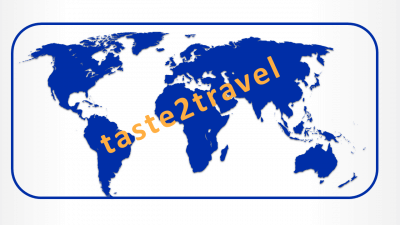Cayman Islands Travel Guide
Welcome to the taste2travel Cayman Islands Travel Guide!
Date Visited: July 2016
Introduction
The Cayman islands are all about three things: sun, sea and wealth. A British Crown Colony whose economy is based on tourism and offshore banking (the territory is the world’s fifth largest financial centre), the islands are blessed with clean, turquoise beaches, lots of sun, a high standard of living and incredible diving and snorkeling sites.
Tourism is aimed at the luxury end of the market with the island attracting wealthy tourists (mostly Americans) who stay in 5-star resorts. In 2016, the territory attracted 2 million visitors, 80% of whom arrived by cruise ship.
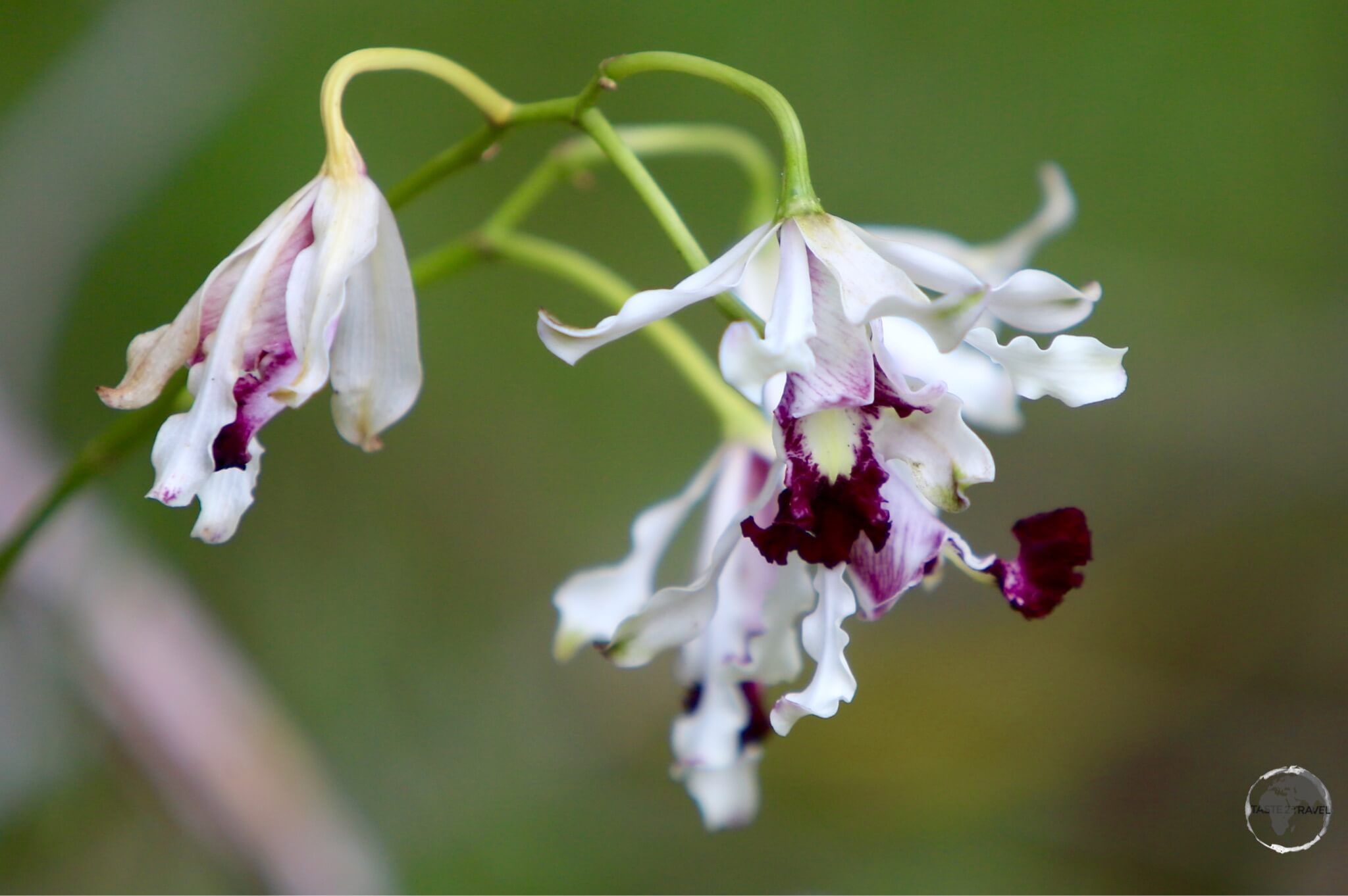
The national flower of the Cayman Islands – the Wild Banana Orchid – in the QEII Botanic Park.
The Cayman Islands is one of the most prosperous territories in the Caribbean, which means this is definitely not a budget-friendly travel destination. Like other affluent Caribbean islands, the cost of living here is at the ‘extortionate‘ end of the scale.
There are ways to reduce costs but even supermarket prices are scary – e.g. US$10 for a slice of watermelon. I hired a car and stayed in a cheap(ish) guest house where I could self-cater (see the ‘Accommodation‘ section below).
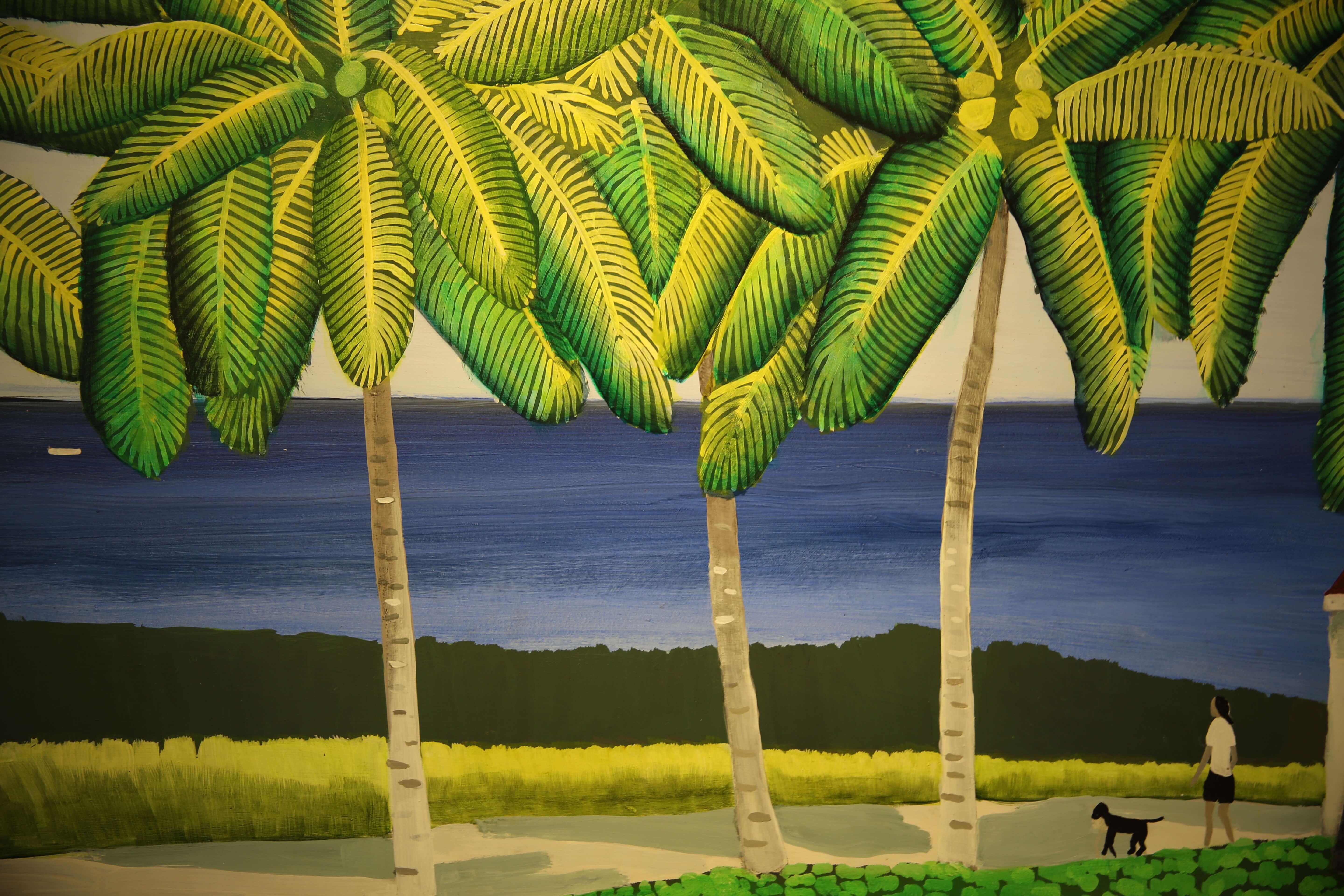
Artwork at the National Gallery of the Cayman Islands.
The territory comprises three islands – the larger island of Grand Cayman (pop:52,600), and the much smaller Cayman Brac (pop: 2,277) and Little Cayman (pop: 170).
The capital of George Town, is located on Grand Cayman, which is where you’ll find the main international airport, the cruise ship dock and almost all hotels and other services. The official currency is the Cayman Islands Dollar (KY$)
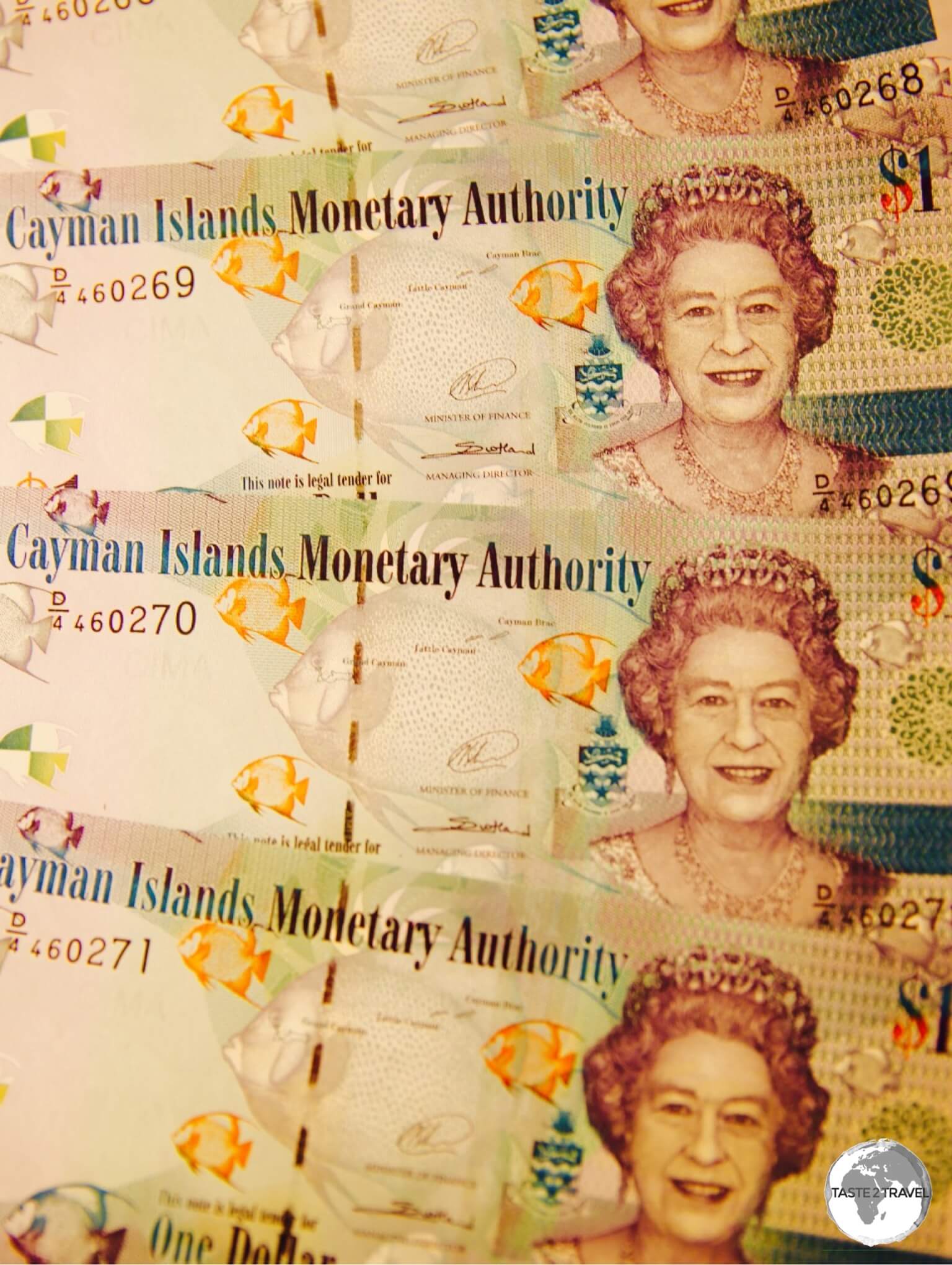
Cayman Islands Dollar.
Despite the high costs, I enjoyed my time on the two islands I visited – Grand Cayman and Cayman Brac. The people are friendly, the environment is pristine, the diving and snorkeling are amazing and then there are the sunset drinks at Macabuca, an ocean-front Tiki Bar in West Bay, which offers the best sunset view on Grand Cayman.
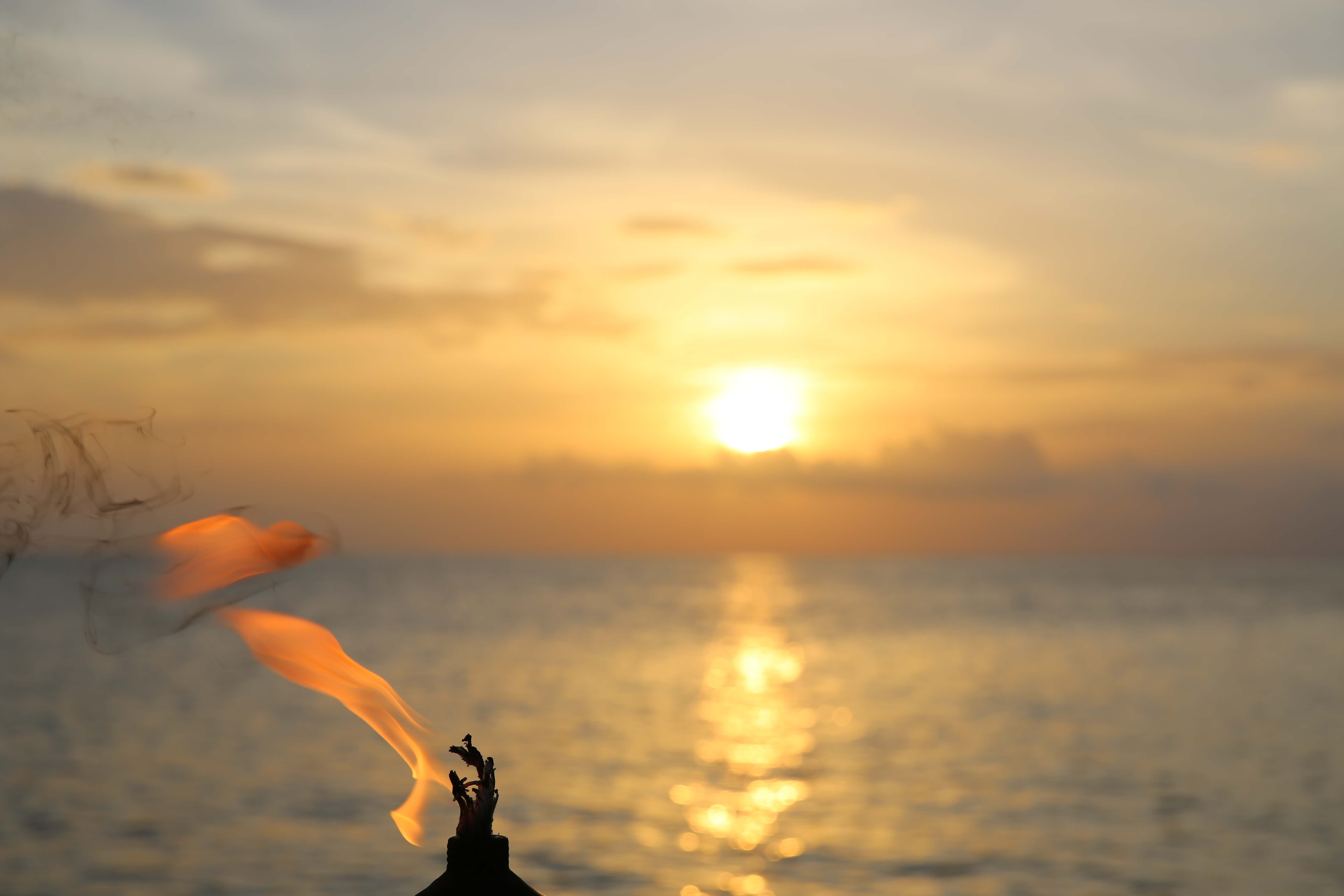
Sunset view from Macabuca bar, Grand Cayman.
Location
Cayman Islands
Cayman Islands
Located in the western Caribbean Sea, 500 miles (800 km) south of Miami, 180 miles (300 km) south of Cuba and 195 miles (315 km) northwest of Jamaica – the Cayman Islands are a British Overseas Territory.
The islands are part of the Greater Antilles – a grouping of the larger islands in the Caribbean Sea, which includes Cuba, Hispaniola, Puerto Rico and Jamaica and are outcrops of the Cayman Ridge – a submarine mountain range. The range rises up from the Cayman Trough, which reaches a maximum depth of 7,686 metres (25,217 ft) – the deepest point in the Caribbean sea – just offshore from the islands.
History
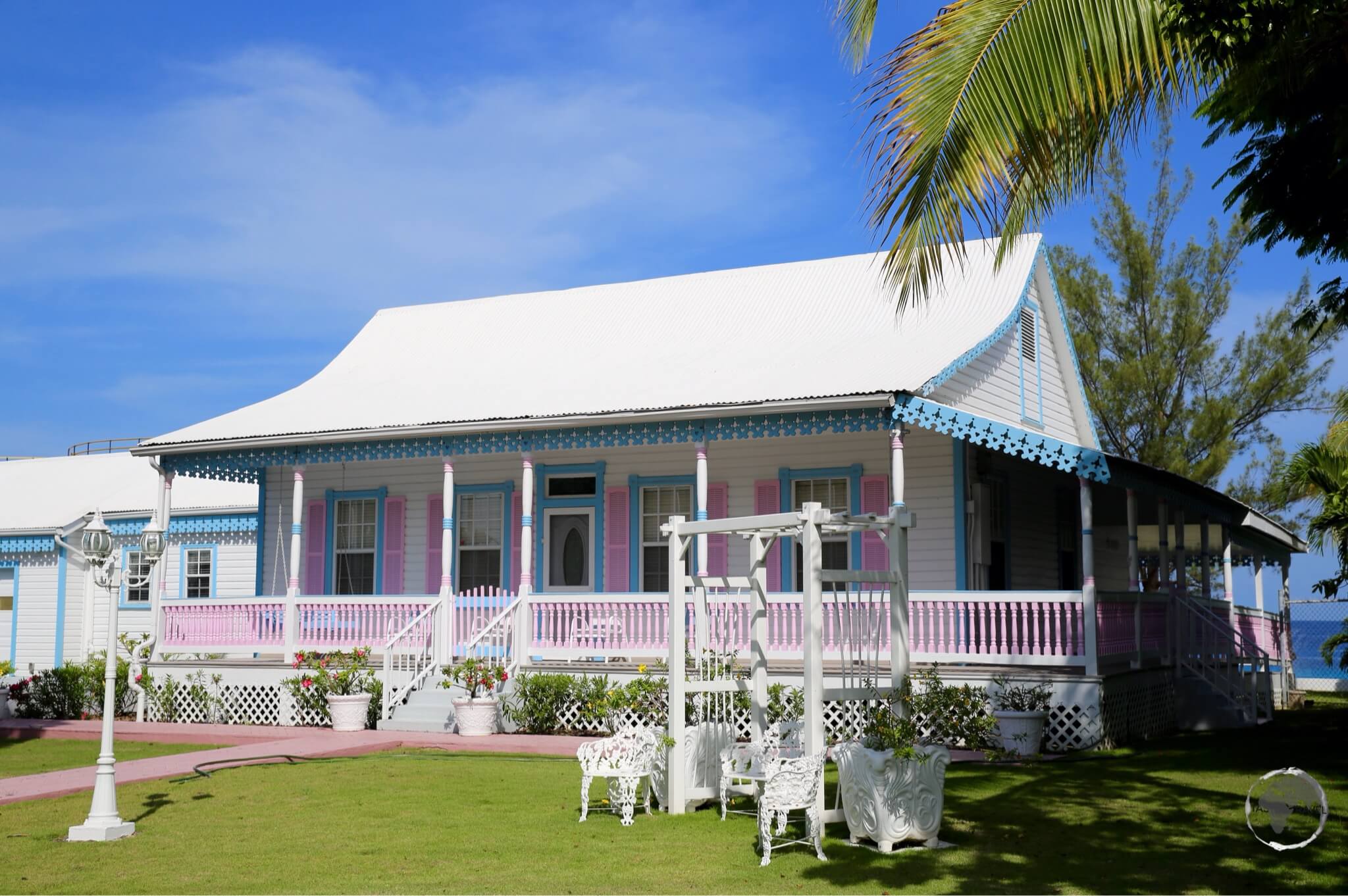
A typical Cayman cottage in George Town.
Unlike other Caribbean islands, the Cayman Islands were never settled by native Indians, remaining undiscovered until Christopher Columbus sighted them on his 4th voyage to the New World in 1503. His ship was sailing to Hispaniola when it was thrust westward toward “two very small and low islands (Cayman Brac and Little Cayman), full of tortoises, as was all the sea all about, insomuch that they looked like little rocks, for which reason these islands were called Las Tortugas.” The islands were later renamed “Caymanas” (Caiman), which is the Carib-Indian word for crocodile, which were also plentiful on the island at the time.
For many years the islands remained unsettled but were a popular calling place for ships sailing the Caribbean and in need of meat for their crews. The first recorded settlements were established on Little Cayman and Cayman Brac by settlers from neighbouring Jamaica, with the islands being administered by Jamaica (then a British colony). The islands were a popular haunt for British privateers (including Sir Francis Drake) who used the islands to replenish stocks of food and water and repair their vessels.
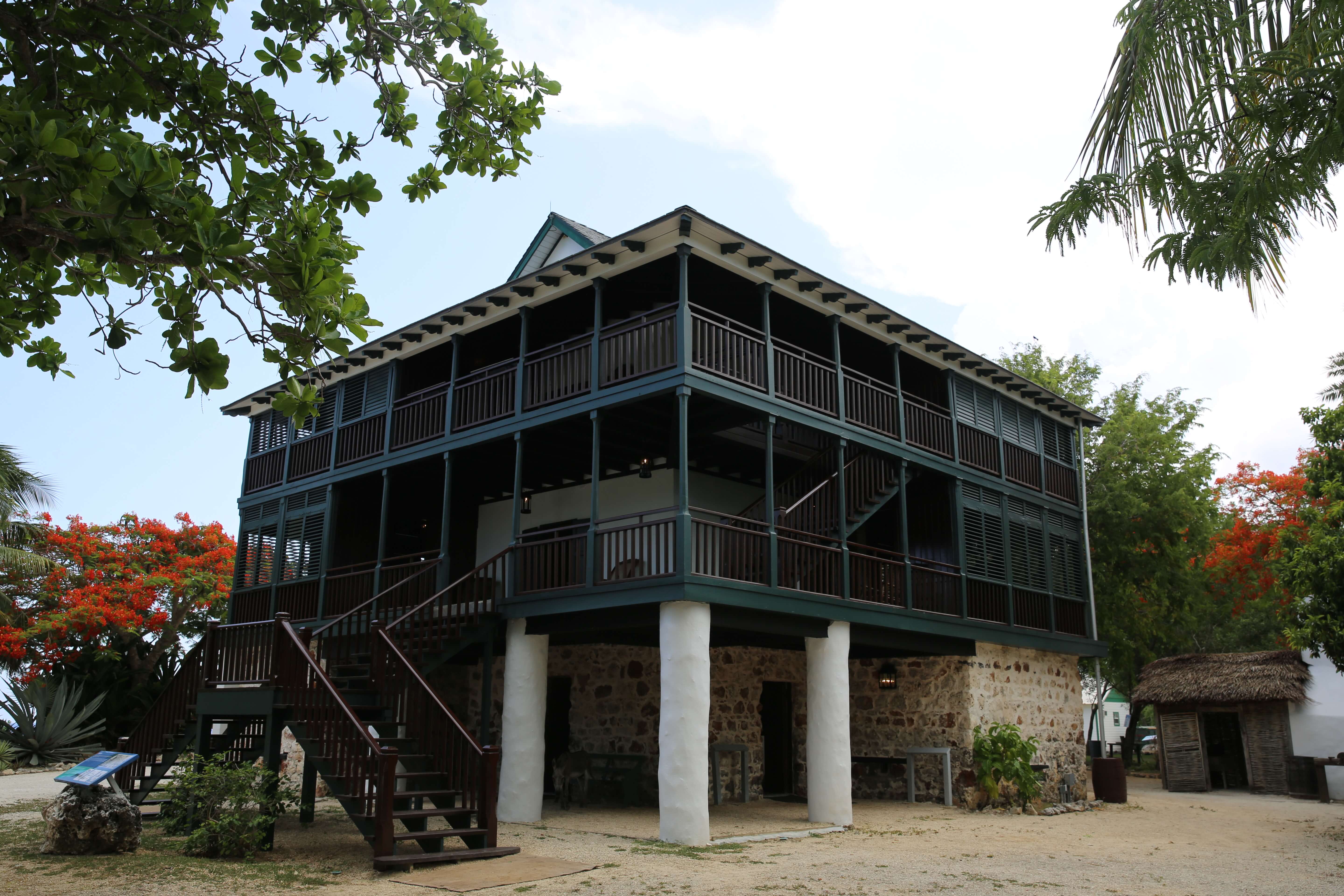
Pedro St. James Castle, the oldest existing building in the Cayman Islands.
The first royal grant of land on Grand Cayman was made by the governor of Jamaica in 1734 and by 1802 Grand Cayman had a population of 933, of whom 545 were slaves. Although the Cayman Islands were regarded as a dependency of Jamaica, the reins of government were very loose, which led to the islanders establishing their own self-government, with matters of public concern decided at meetings of all free males. In 1831 a legislative assembly was established after a meeting at Pedro St. James Castle.
Despite this development – in 1863 – the British parliament formally made the Cayman Islands a dependency of Jamaica. When Jamaica achieved independence in 1962, the Islands opted to remain under the British Crown, and an administrator appointed from London assumed the responsibilities previously held by the governor of Jamaica. The Cayman Islands today are a British Overseas Territory, with a Crown-appointed Governor, a Legislative Assembly and a Cabinet.
Sights
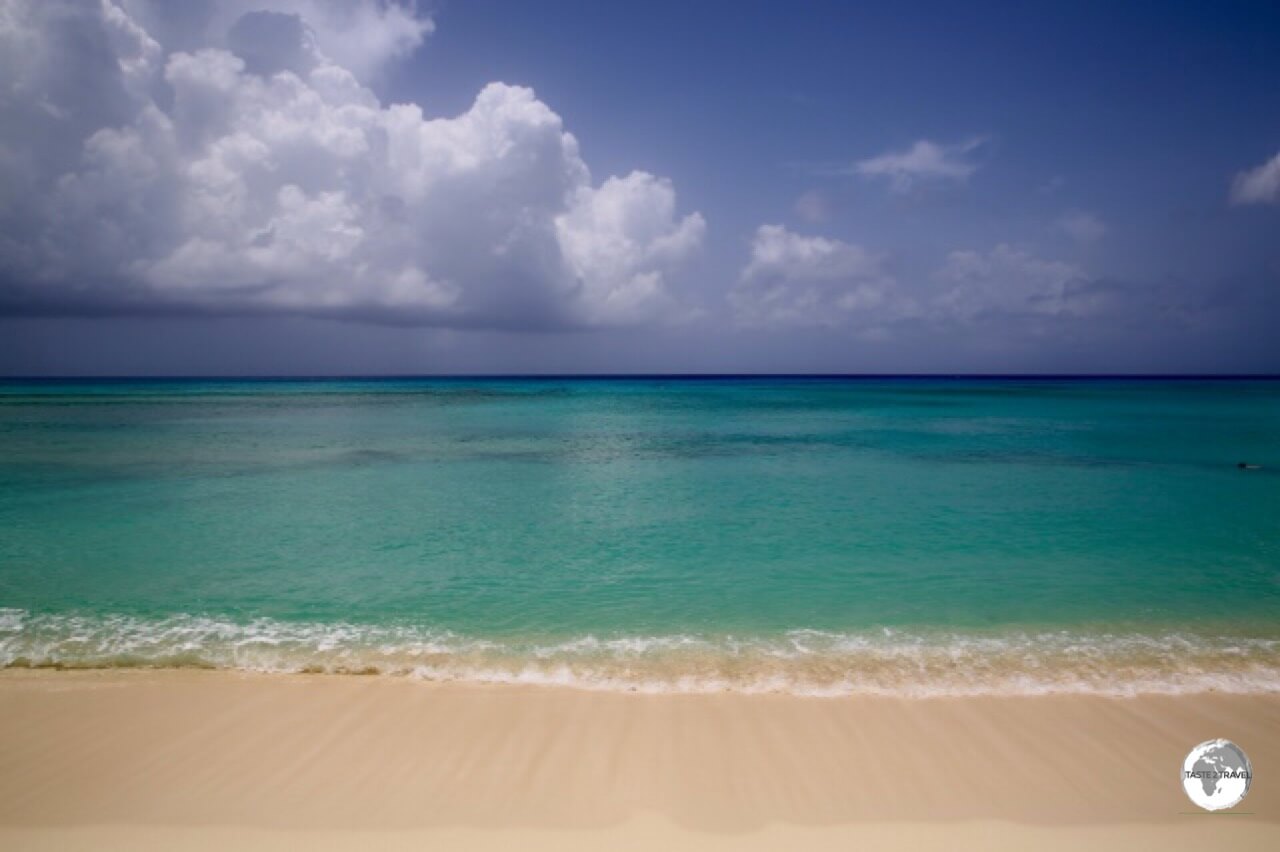
West Bay Beach on Grand Cayman.
Grand Cayman
While the main draw-card of Grand Cayman are the pristine, white-sand beaches and numerous dives sites, there are plenty of other land-based sights to explore. I spent seven days driving around the island, which allowed me enough time to explore most places at a leisurely pace.
George Town
With a population of 28,000, George Town is the largest city and the capital of the Cayman Islands. The city is known as a financial hub and a port of call for cruise ships. During my visit, multiple cruise ships were in town every day, which added a lot of extra traffic and (pedestrian) congestion to the normally relaxed downtown area. Due to it being a port of call, city shops tend to cater to the needs of cruise ship passengers, with a cluster of souvenir and tax-free shops. In between are office towers which house financial services companies.
Housed in a 19th-century building on Harbour Drive, the one site worth visiting downtown is the Cayman Islands National Museum. The museum displays a collection of Cayman artifacts and features natural and cultural history displays.
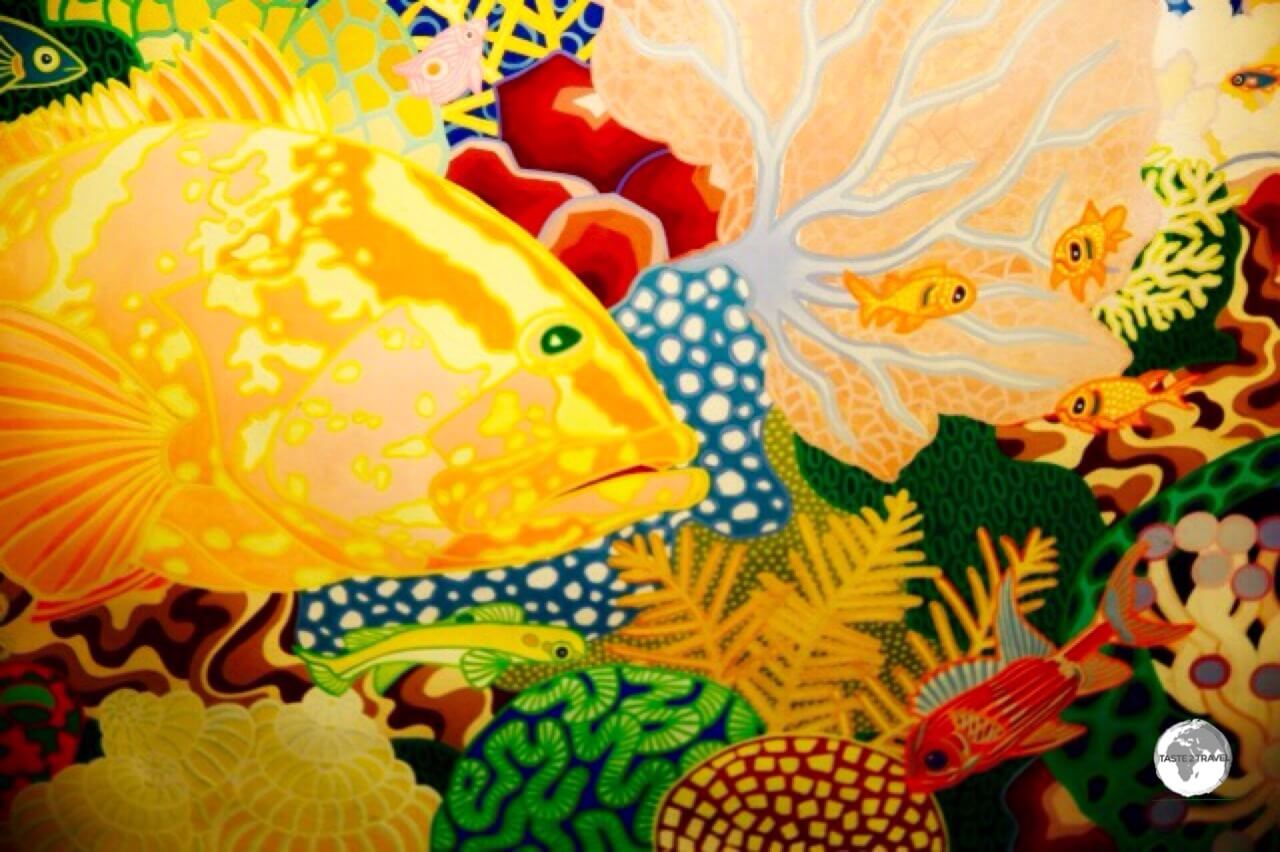
Colourful artwork at the National Gallery of the Cayman Islands.
North of town, on Easterly Tibbets Highway, the newly-built National Gallery of the Cayman Islands, showcases art from the Cayman Islands in a 3-level, lofty gallery, which also includes a gift shop, art studio, library, auditorium and beautiful gardens adorned with sculptures from local artists.
If you continue north along Easterly Tibbets Highway, you’ll reach Camana Bay, a sprawling waterfront development which includes a shopping mall, restaurants, bars, cafes, cinemas, farmers market and more. The coffee served at Cafe Del Sol is very good, while the Waterfront Urban Diner does a mean Eggs Benedict for breakfast. On the coast, a short drive from Camana Bay, is Seven Mile Beach – the main tourist area which stretches along a pristine, white sand -beach.
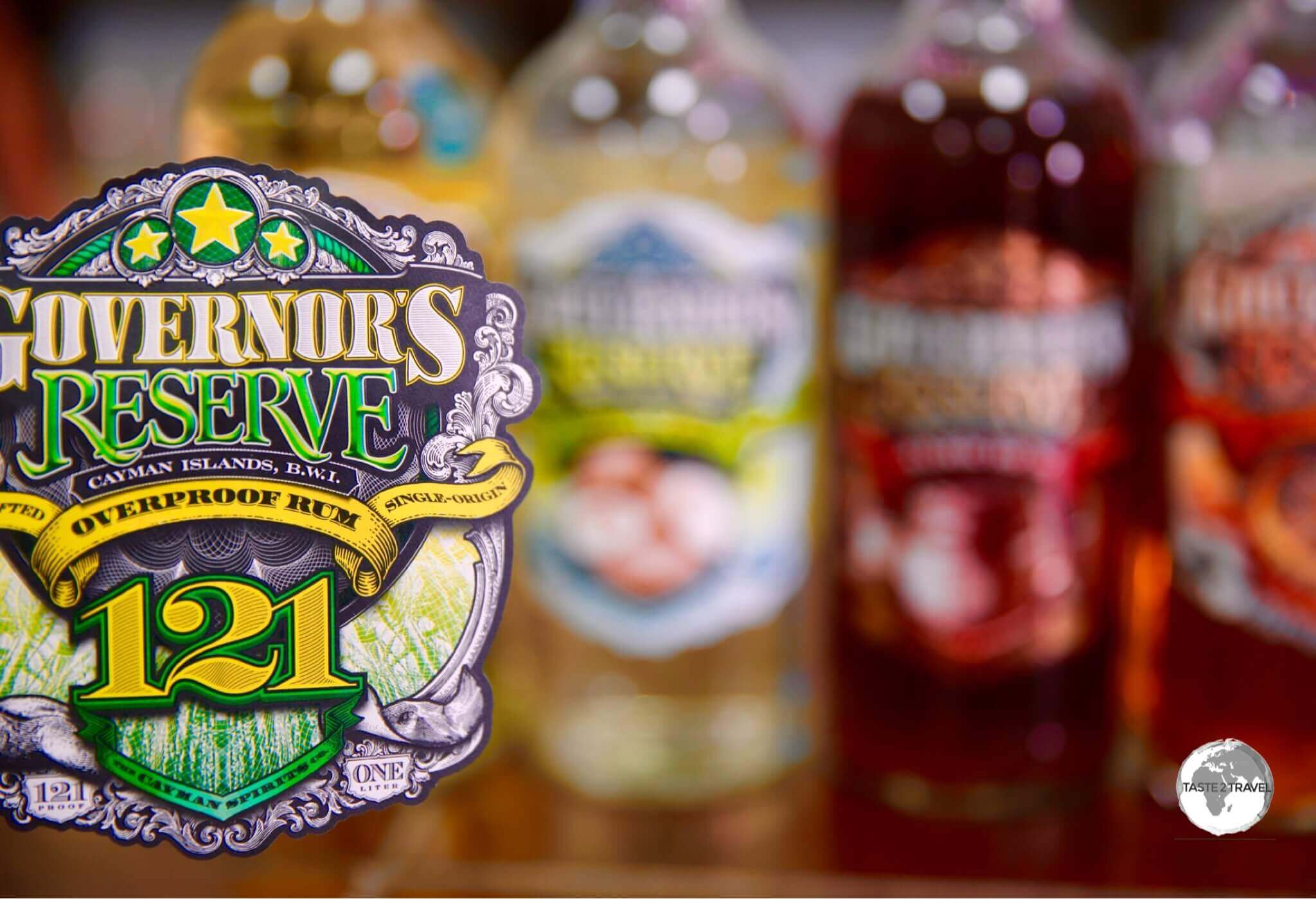
Governor’s Reserve Rum, Cayman Spirits Company.
On the outskirts of George Town is the Cayman Spirits Company, who offer informative tours (US$15) of their distillery, including a sampling of their products. The company’s most famous tipple is it’s Seven Fathoms rum, which is matured at 43 feet (7 fathoms) below the sea (in a secret offshore location) in American oak barrels. The moving sea currents gently rock the spirit inside the barrels while the sea maintains a constant ambient temperature, producing an excellent, smooth rum.
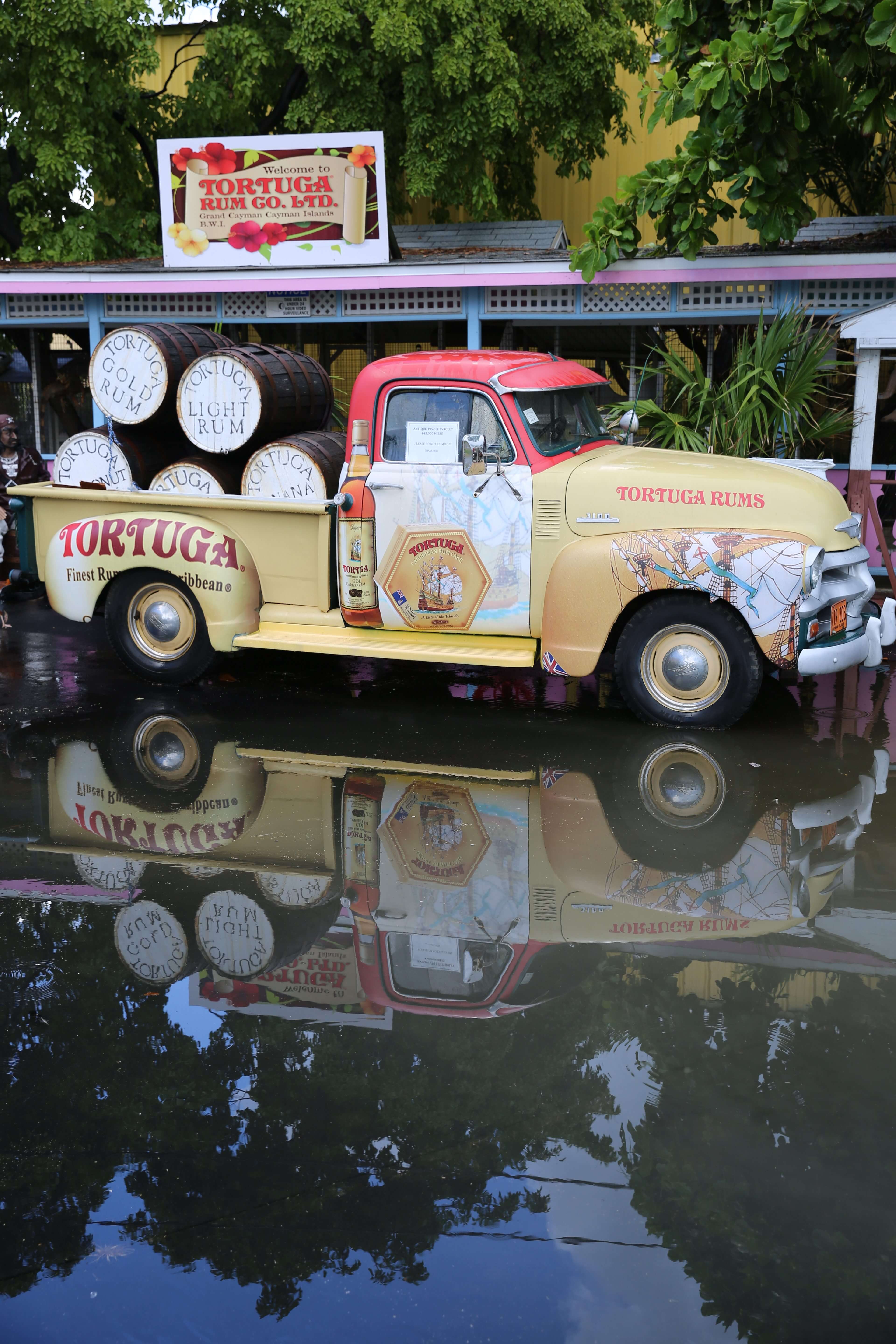
The Tortuga Rum Factory.
Also nearby is the Tortuga Rum Factory – not technically a factory but rather a shop where tourists (bused in ‘en masse’) can peer through a window to see the famous rum cakes being made and packaged. There is an onsite shop where you can purchase different types of cakes.
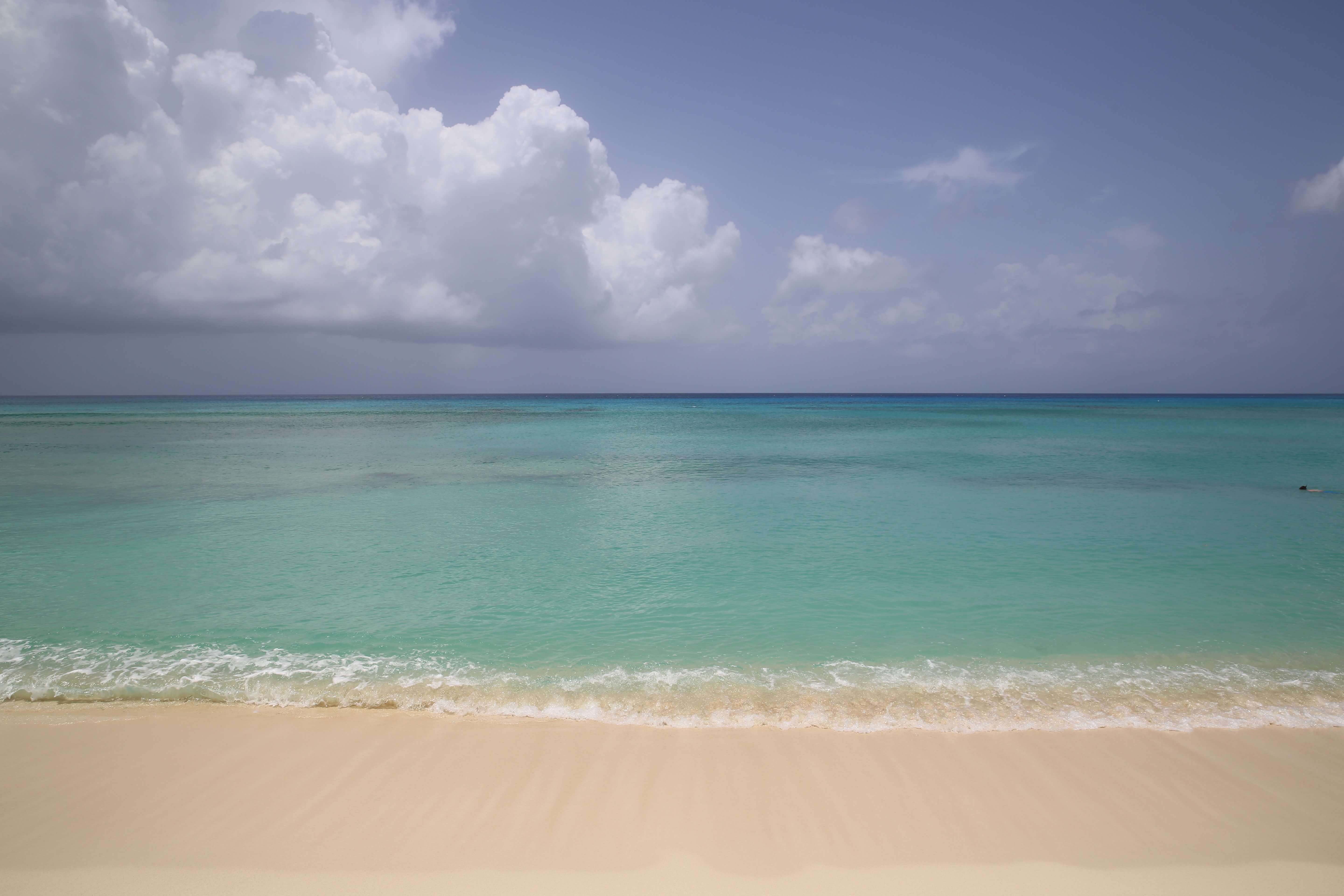
West Bay Beach, Grand Cayman.
While Seven Mile beach is special, a short drive north is the equally spectacular Cemetery Beach, which offers turquoise waters, great snorkeling and white powdery sand – but without the tourist hoards. Further up the coast are a string of beautiful quiet, beaches, including West Bay Beach.

Green Iguana on Grand Cayman.
Located at the western end of the island, the Cayman Turtle Centre is a glorified zoo and tourist trap, which offers paying tourists the opportunity to kiss, hug, and pass around young sea turtles and swim with adult turtles.
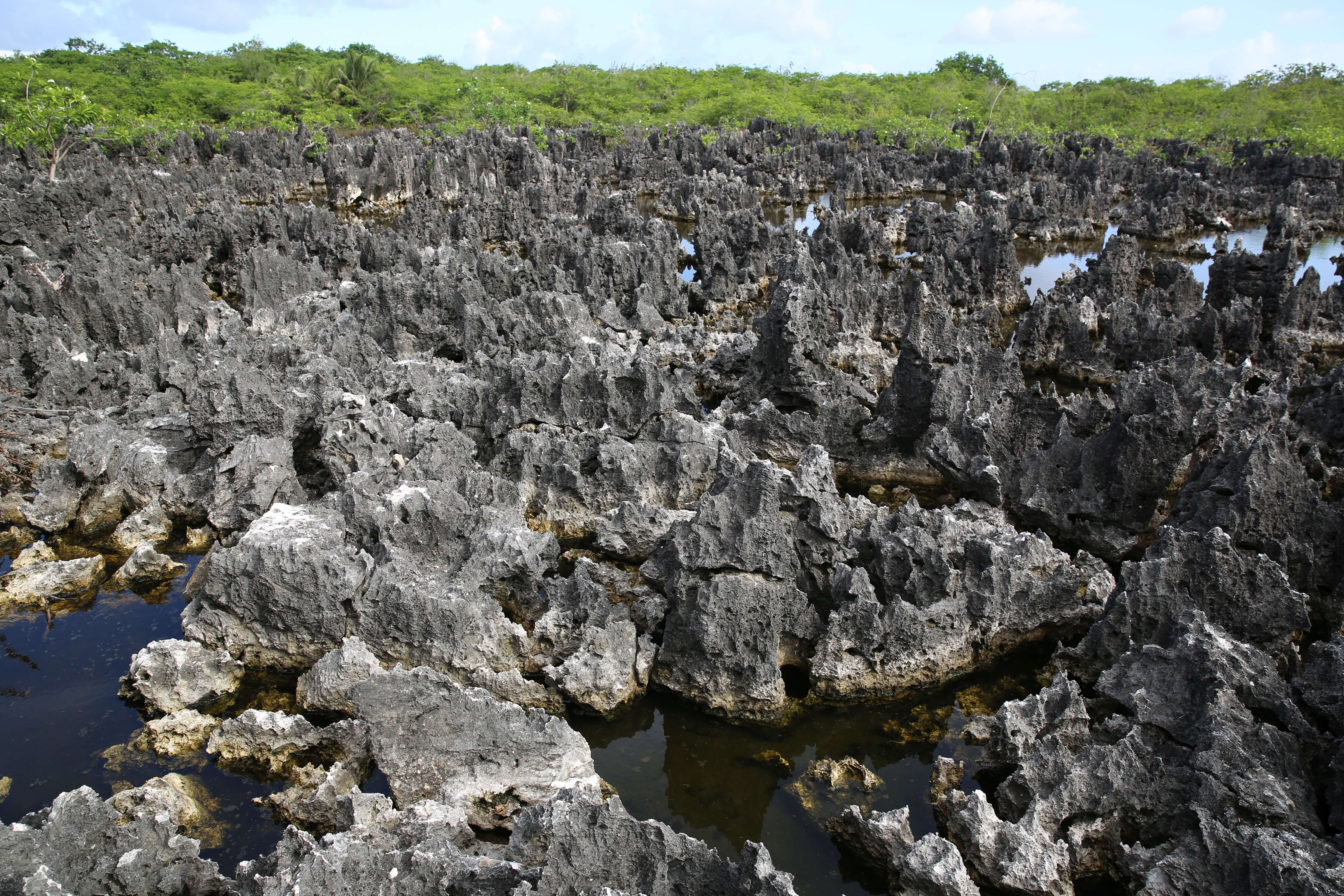
The rocky, limestone landscape at Hell.
Who can honestly say they’ve been to Hell and back? On Grand Cayman you can visit the small settlement of Hell, where you can send postcards from the Hell post office and buy tacky ‘Hell’ souvenirs. The area gets its name from the jagged, spongy pinnacles of black-covered limestone – all very inhospitable and unwelcoming. Upon seeing the site, an English colonial minister once exclaimed “This must be what Hell is like!” and the name stuck.
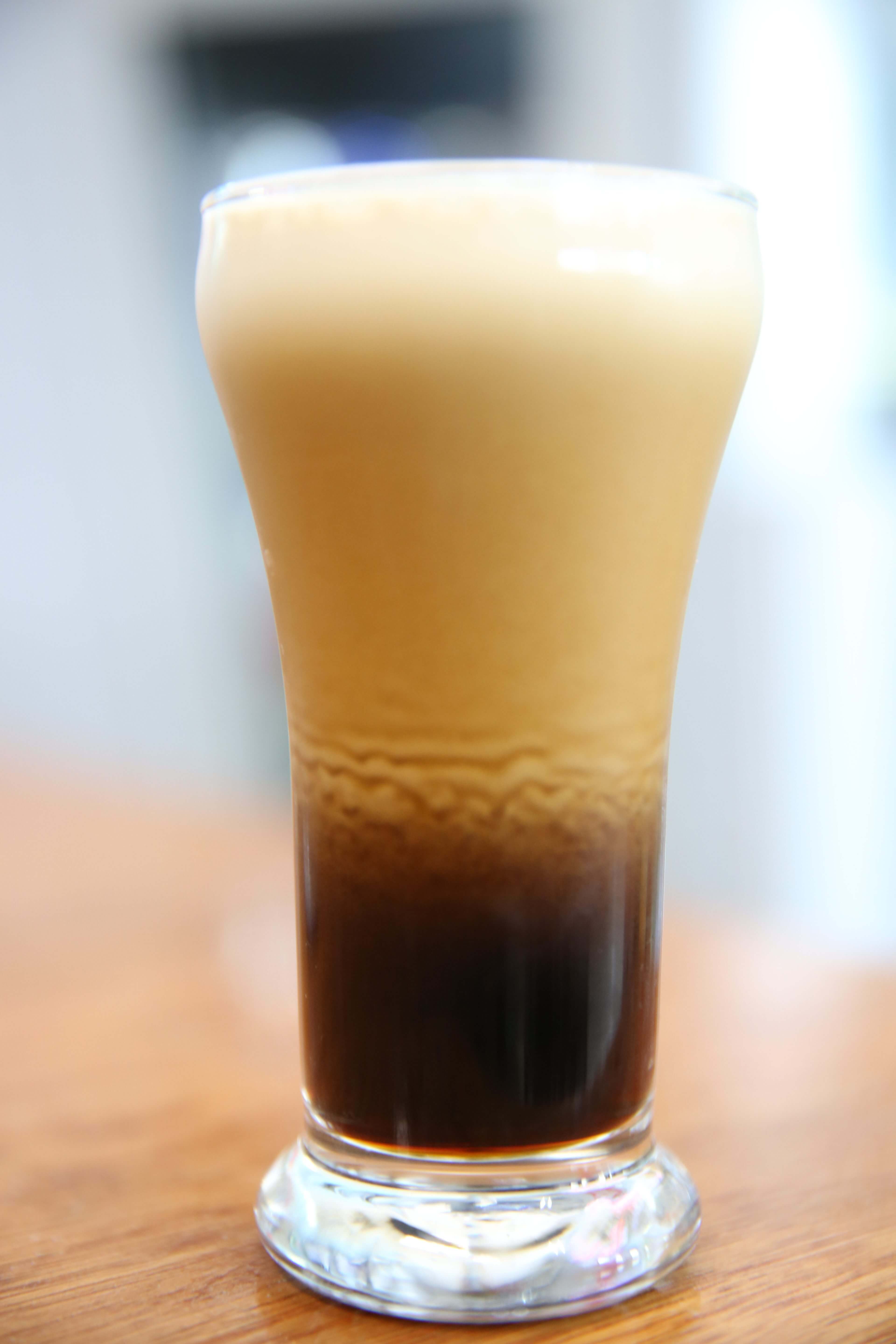
The amazingly smooth stout at the Cayman Islands Brewery.
Located on the south coast, a short drive east of George Town is the Cayman Islands Brewery, which is well worth visiting. Tours of the small brewery cost US$5 and include a free sample of their wonderful craft beers, which include the Mango Tango. They have an onsite gift shop and bar where you can sample their different brews, including their amazingly smooth, creamy stout – fresh from the keg.
Heading further east, along the south coast road, you soon reach sleepy Bodden Town, the original capital of the Cayman islands and home to the nearby Pedro St. James Castle – the oldest existing stone building on the islands. At a time when most people lived in simple, tiny, thatch-covered houses, a wealthy Englishman, using slave labour from Jamaica, created a three-storey building from stone. Set in immaculate grounds, overlooking the rugged south coast, the museum features a 4D-film which tells the history of the islands.
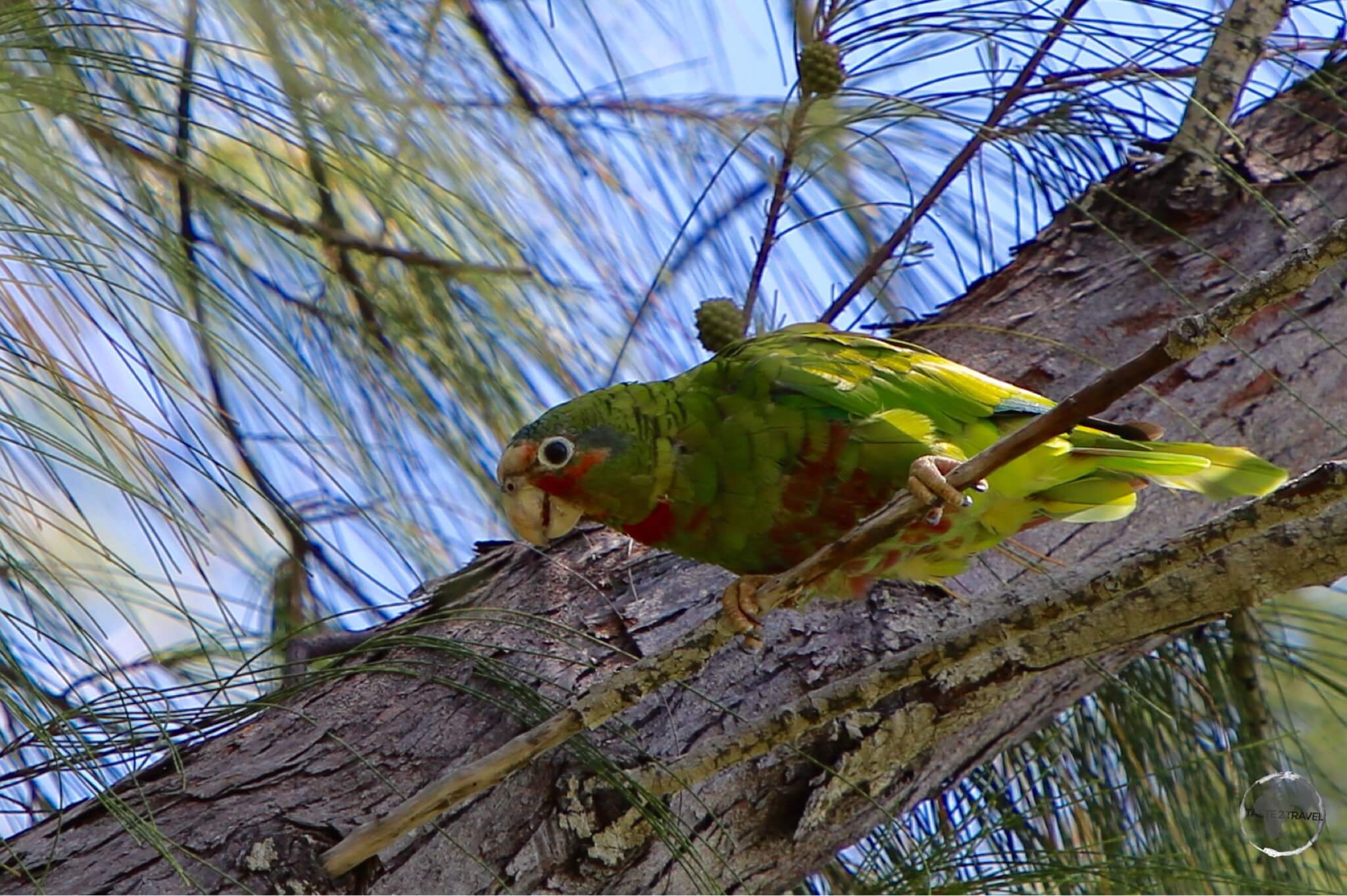
The elusive Grand Cayman Parrot on Grand Cayman.
Located in the centre of the island, the Queen Elizabeth II Botanic Park is a must-visit for those interested in the flora and fauna of the Cayman Islands. The park includes several themed gardens, a boardwalk (where I photographed the woodpecker below), Cayman Island Parrots and the elusive Blue Iguana (so elusive, I never saw one). If you wish to see the national flower – the Wild Banana Orchid – you’ll find it on the walking trails.
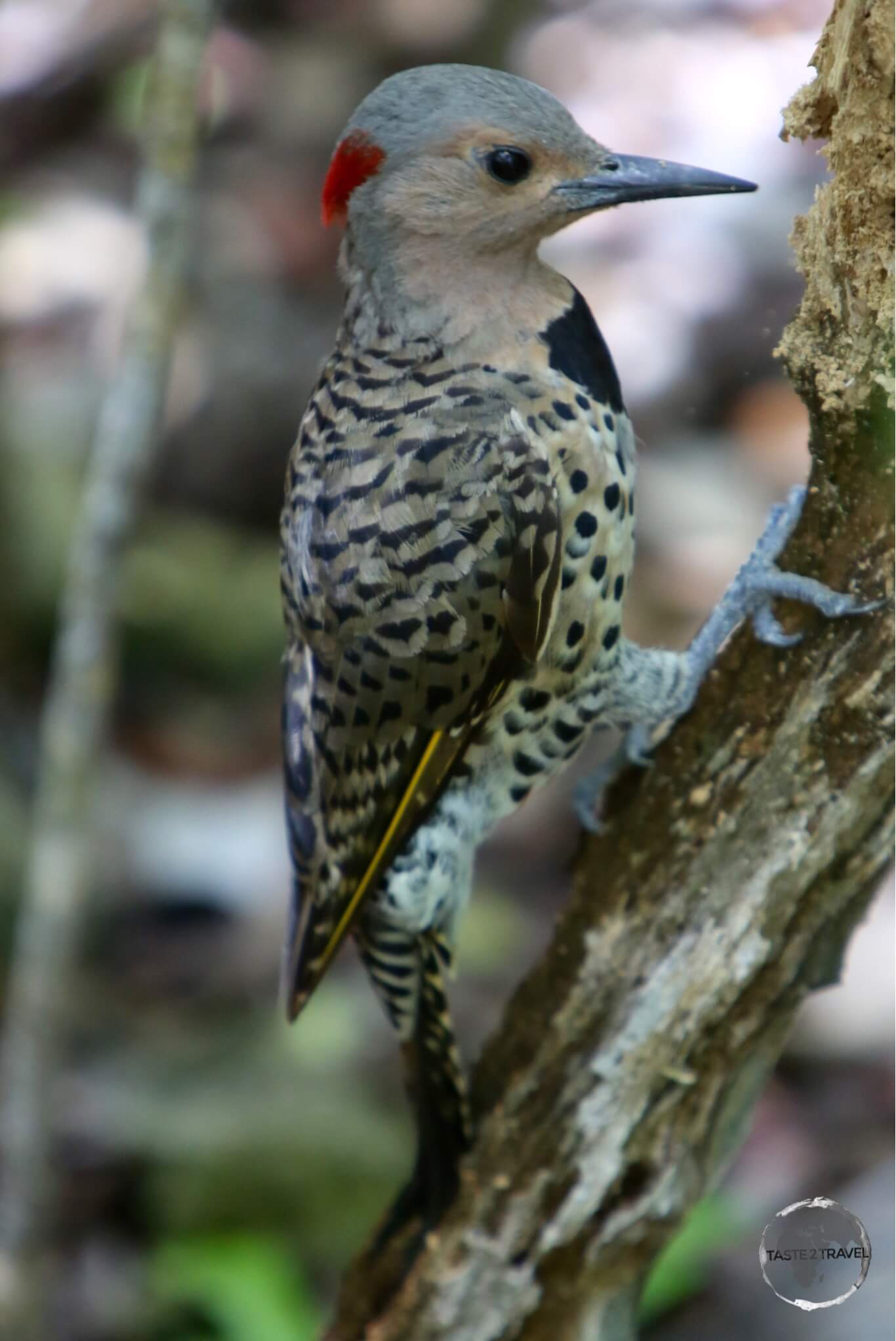
West Indian Woodpecker at the QEII Botanical Gardens, Grand Cayman.
On the north side of the island is the popular beach playground of Rum Point, which offers a beautiful sandy beach and the Rum Point Club – a nice venue for lunch. At the end of the road south of Rum Point is the secluded Starfish Point – a shallow, sandy beach famous for its resident army of colourful star fish.
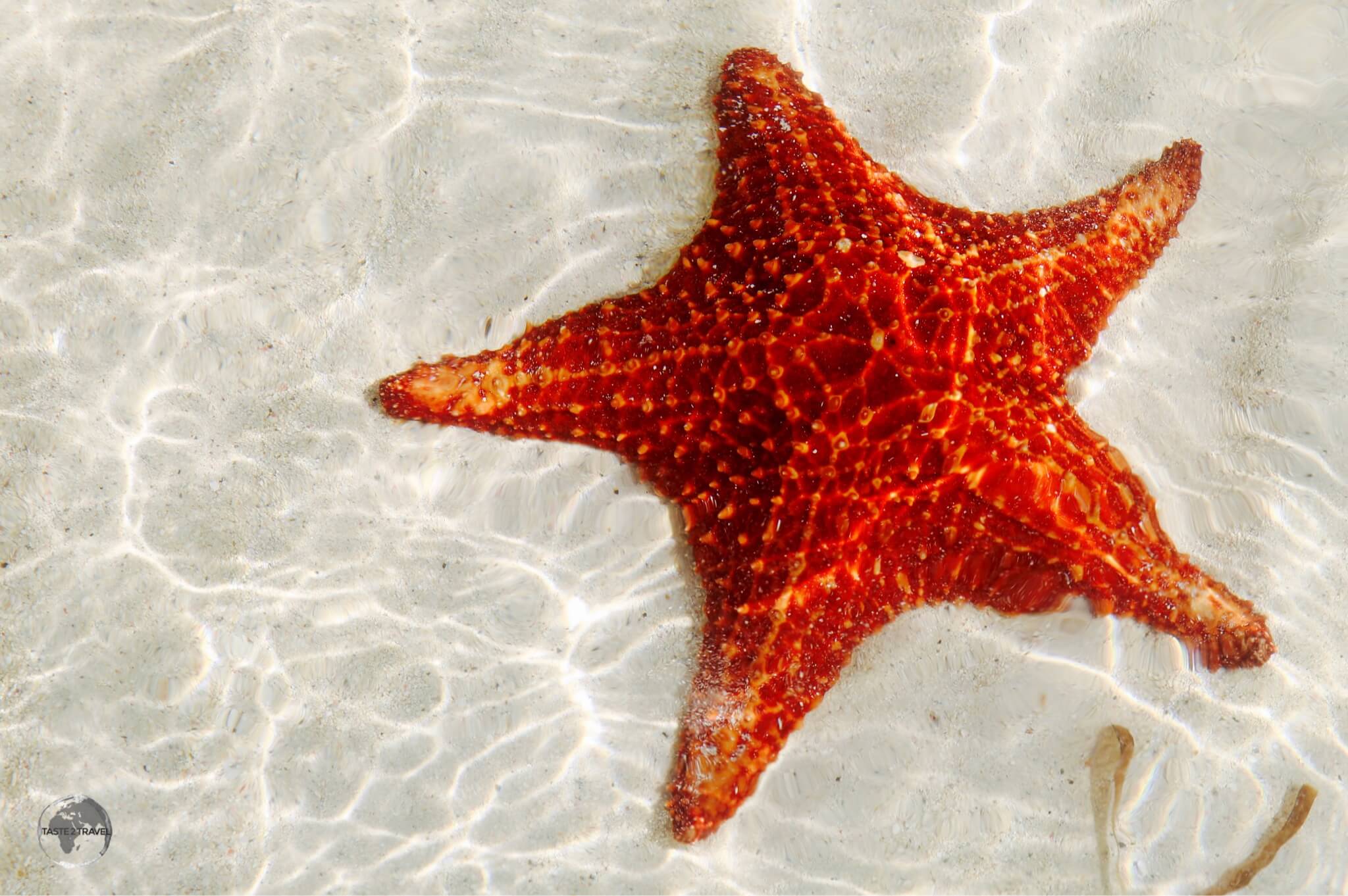
Starfish at Starfish Point, Grand Cayman.
Stingray City
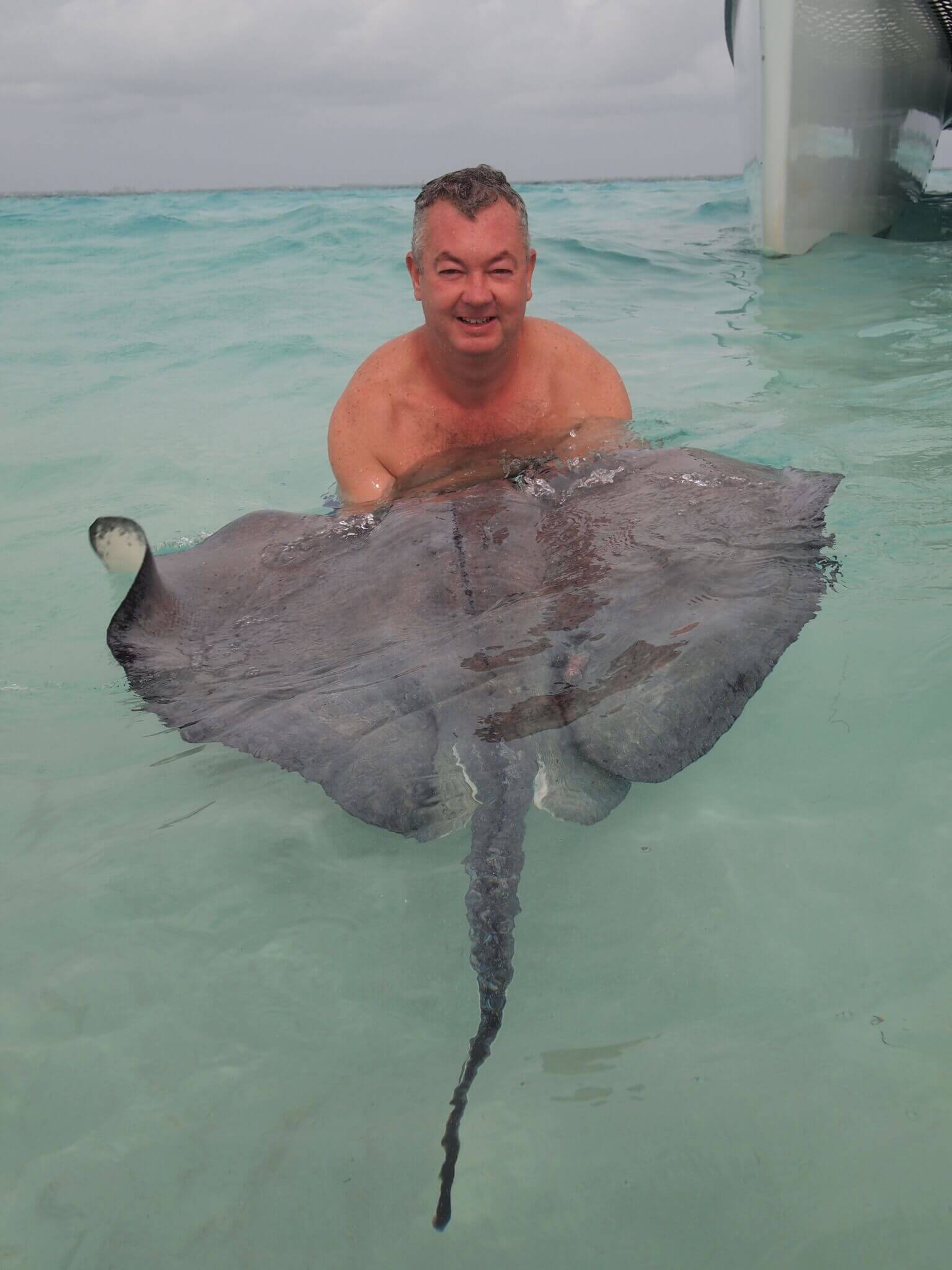
Getting friendly with a local at Stingray City, Grand Cayman.
Located in the North Sound, Stingray City is the most popular attraction on the Cayman Islands. Definitely a tourist trap but one worth doing – this is an amazing natural attraction where swimmers get to interact and feed Atlantic Southern stingrays on a shallow sandbar in the middle of the sound.
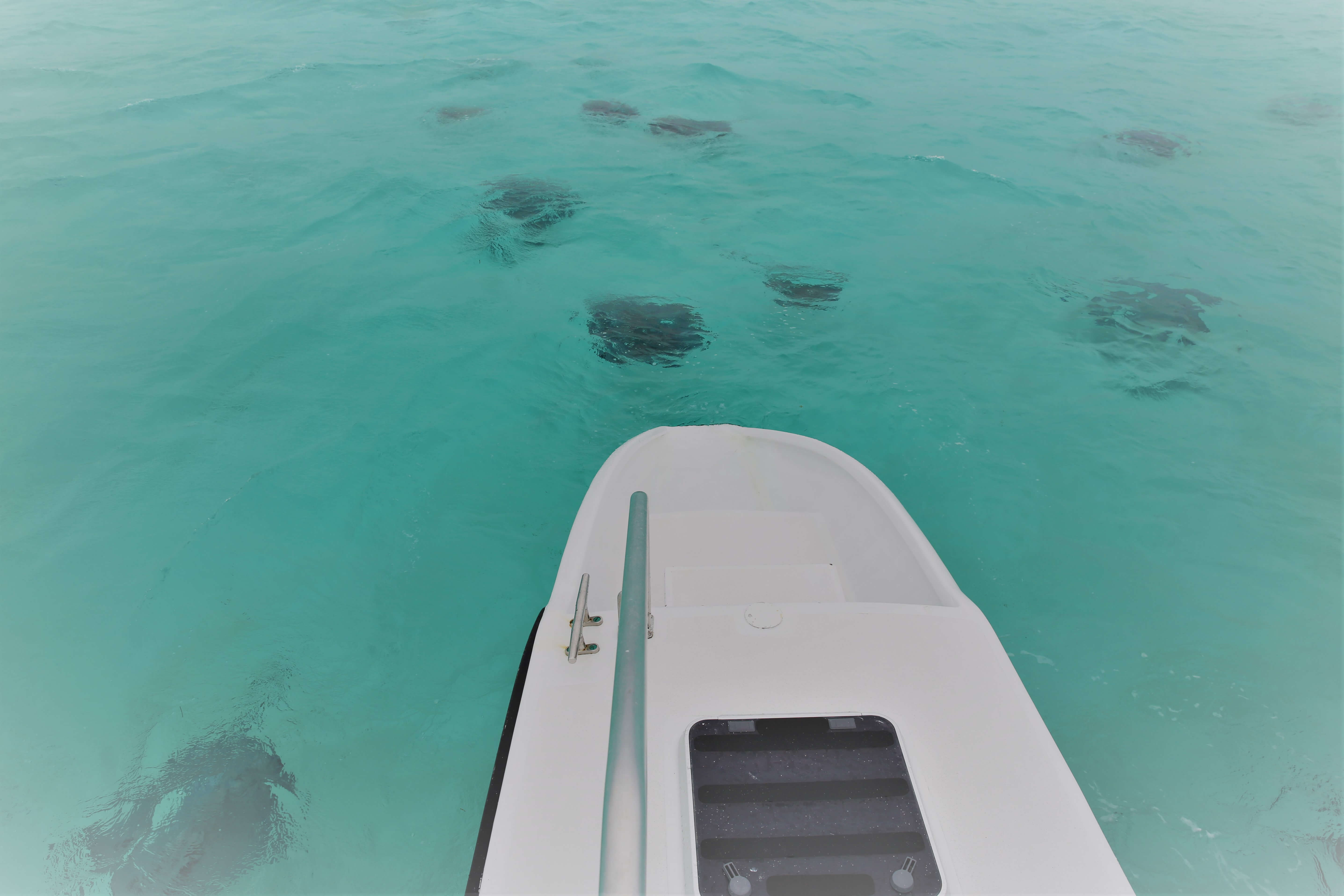
Stingray’s surrounding our boat at Stingray City, Grand Cayman.
Diving
While on Grand Cayman, I did two dives with Eden Rock Diving Centre, who are located on the coast road in downtown George Town. The first dive took me to the Devil’s Grotto, an underwater cavern whose entrance is guarded by a school of (very large) Tarpon. Inside the cave we swam past cruising Tarpon and Barracuda in a very tight space – spectacular stuff! On our 2nd dive we dived Eden Rock which offers a rabbit-warren of caves to explore.
Another diving highlight was diving the (deliberately-wrecked) Kittiwake, an ex-USA navy vessel which was sunk in 2011 to make an artificial reef off Grand Cayman’s Seven Mile Beach. Boasting five decks – and lots of large cut-outs to facilitate easy access – the wreck sits in 18 metres (60 feet) of crystal-clear water.
Cayman Brac
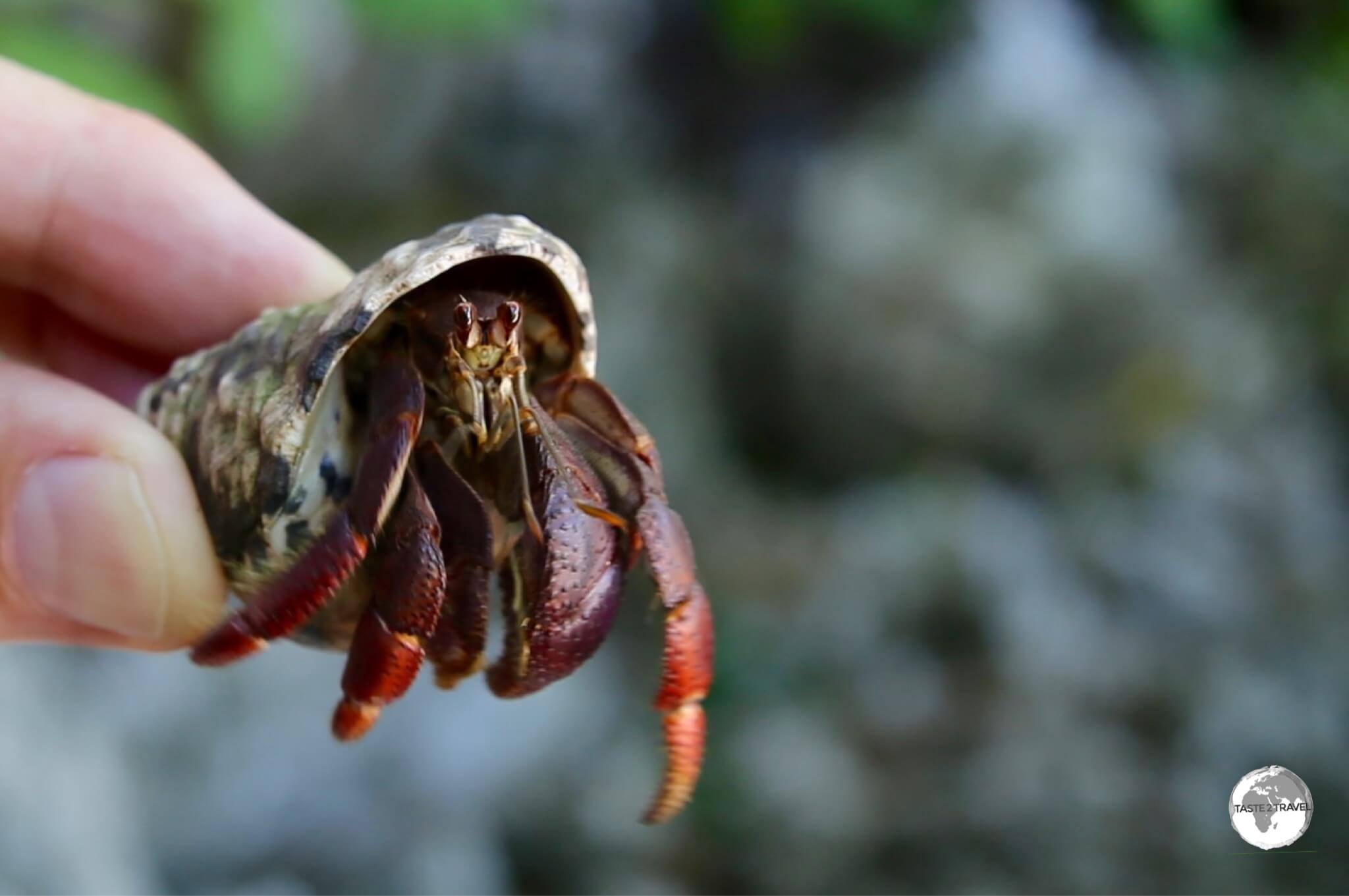
Hermit crabs can be found all over Cayman Brac.
Cayman Brac boasts the most dramatic landscape of the three islands and is named after the islands’ predominate geographical feature – a limestone ridge that runs along the spine of the 19-km long island, gradually rising towards the east end where it ends in a dramatic 150-foot coastal bluff. The Brac (Gaelic for “Bluff”) is home to many caves which (over the centuries) have offered shelter to locals during hurricanes and have been the preferred hiding place for pirate’s buried treasure. Cayman Brac offers lots of natural attractions, rather than man-made ones and is ideal for those who like diving, snorkeling, hiking and the outdoors.
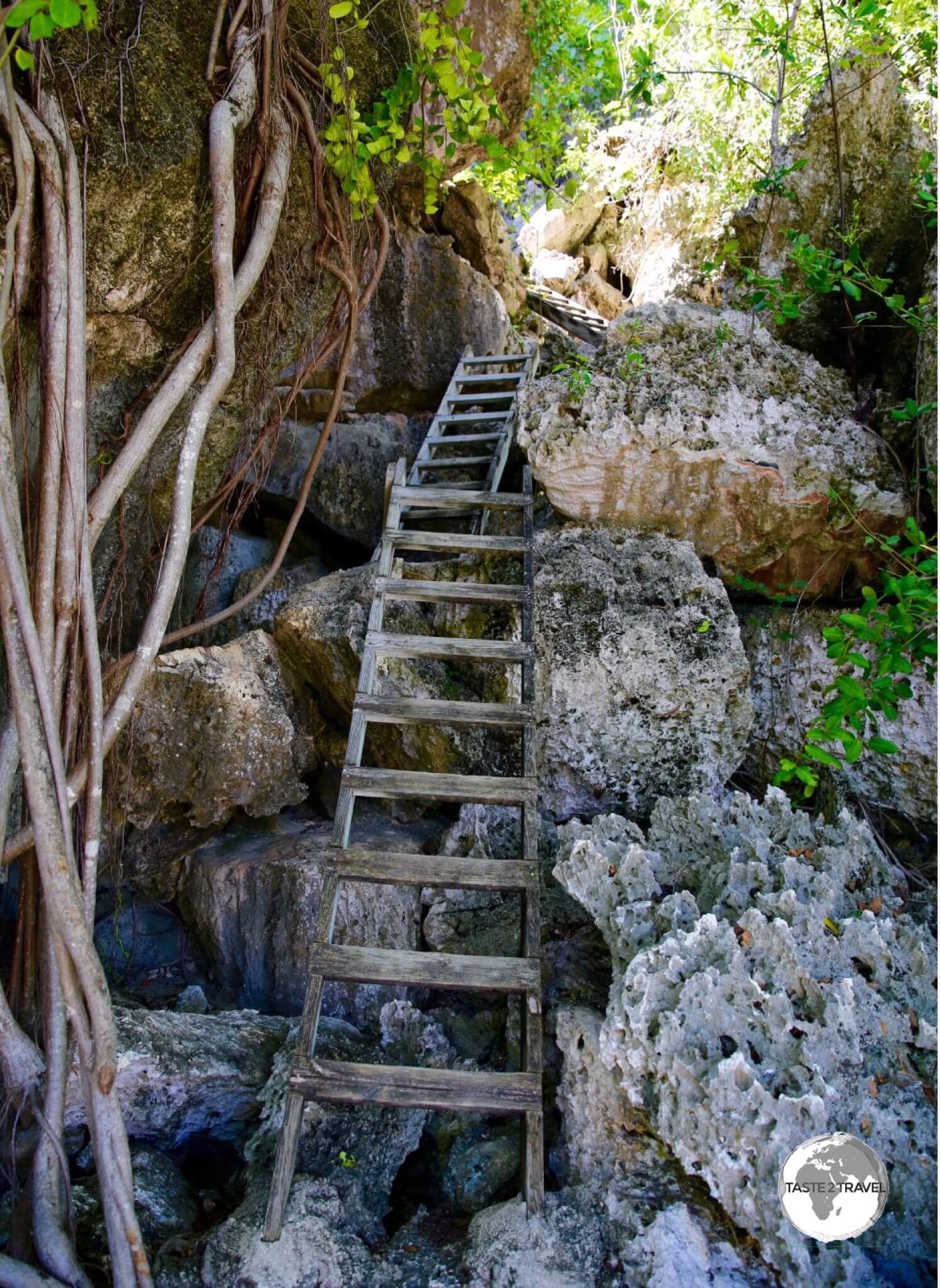
Entrance to Great Cave on Cayman Brac.
While there are reportedly thousands of caves in the bluff, only a handful are open to tourists and all are easily accessible. Many are home to bats and hermit crabs and feature rough limestone terrain so proper footwear is advised as is a torch. I explored the following caves:
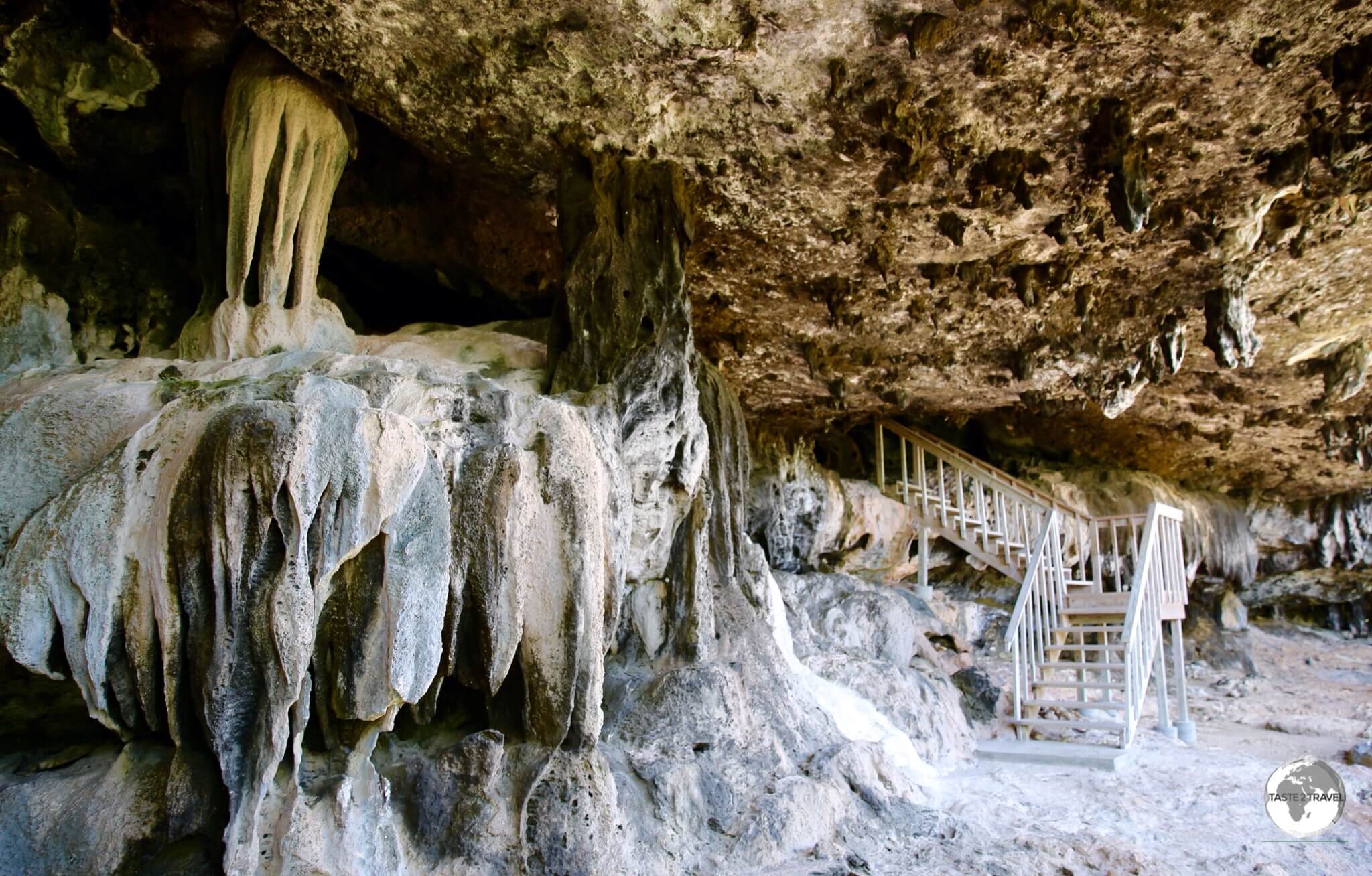
Entrance to Bat Cave on Cayman Brac.
- Bat Cave – This cave is easily accessed via a wooden staircase and is home to hoards of roosting Jamaican fruit bats.
- Rebecca’s Cave – This cave features the grave of (baby) Rebecca Bodden who died while her family were fleeing to take shelter in the cave during the hurricane of 1932.
- Half-Way Ground Cave – More commonly known as Skull Cave because of the close resemblance the cave has to a skull, this cave is located on the North Side road, close to the Cayman Brac Museum.
- Great Cave – Located at the eastern end of South Side road, Great cave is accessed via a set of wooden ladders. The highlight is the magnificent central chamber which begs exploration.
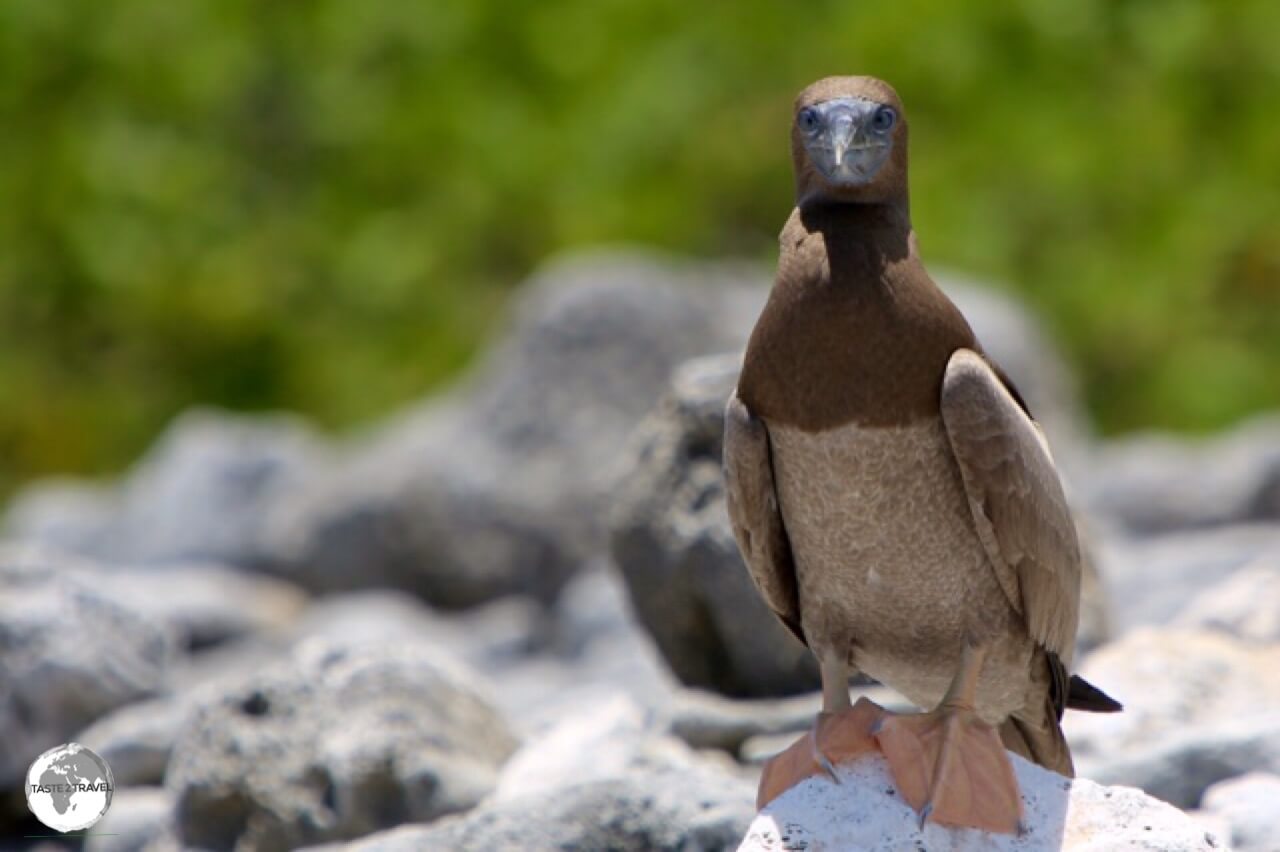
Juvenile Brown Booby on Cayman Brac.
Hiking trails crisscross the bluff, offering bird watchers the opportunity to photograph the (endemic) Cayman Brac Parrot, the Brown Booby and many other migratory sea birds.
The best place to photograph nesting boobies is along the lighthouse trail which meanders along the top of the bluff from the lighthouse. The clifftop views from the small lighthouse are spectacular. The trail is very remote and isolated so it’s best to bring plenty of water and sun screen. I also walked along the beach at the bottom of the bluff (accessible from the end of the North Side road) and saw many juvenile boobies along the isolated beach.
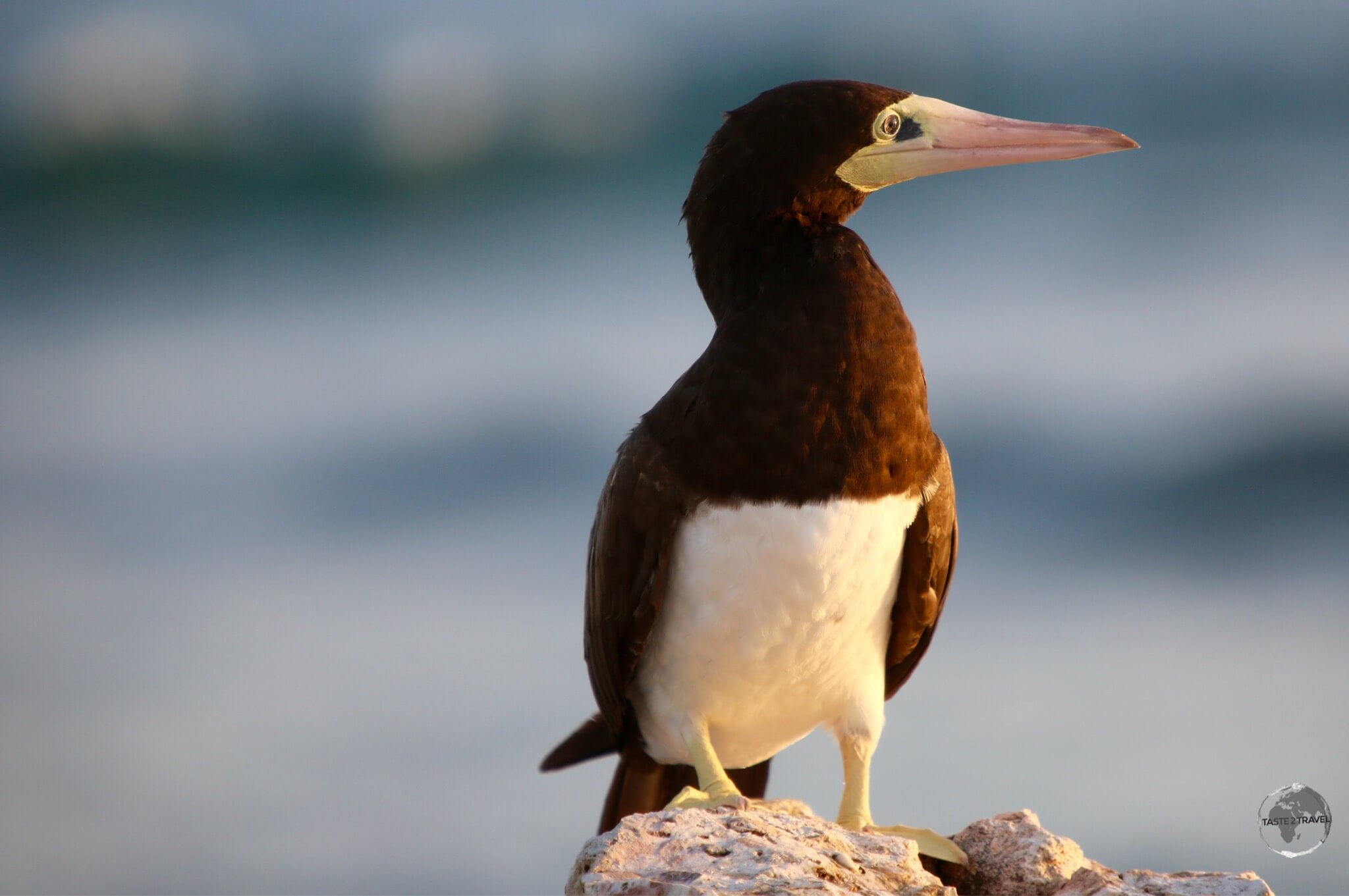
Adult Brown Booby on Cayman Brac.
On the road to the lighthouse, you’ll pass through the Cayman Brac Parrot preserve. You can park your car in a small car park on Major Donald drive, walk back down the road for 100 metres until you come to a sign-posted walking trail. The first few hundred metres of the trail consists of a nice boardwalk, which traverses the spiky, rough, limestone terrain that covers the area.
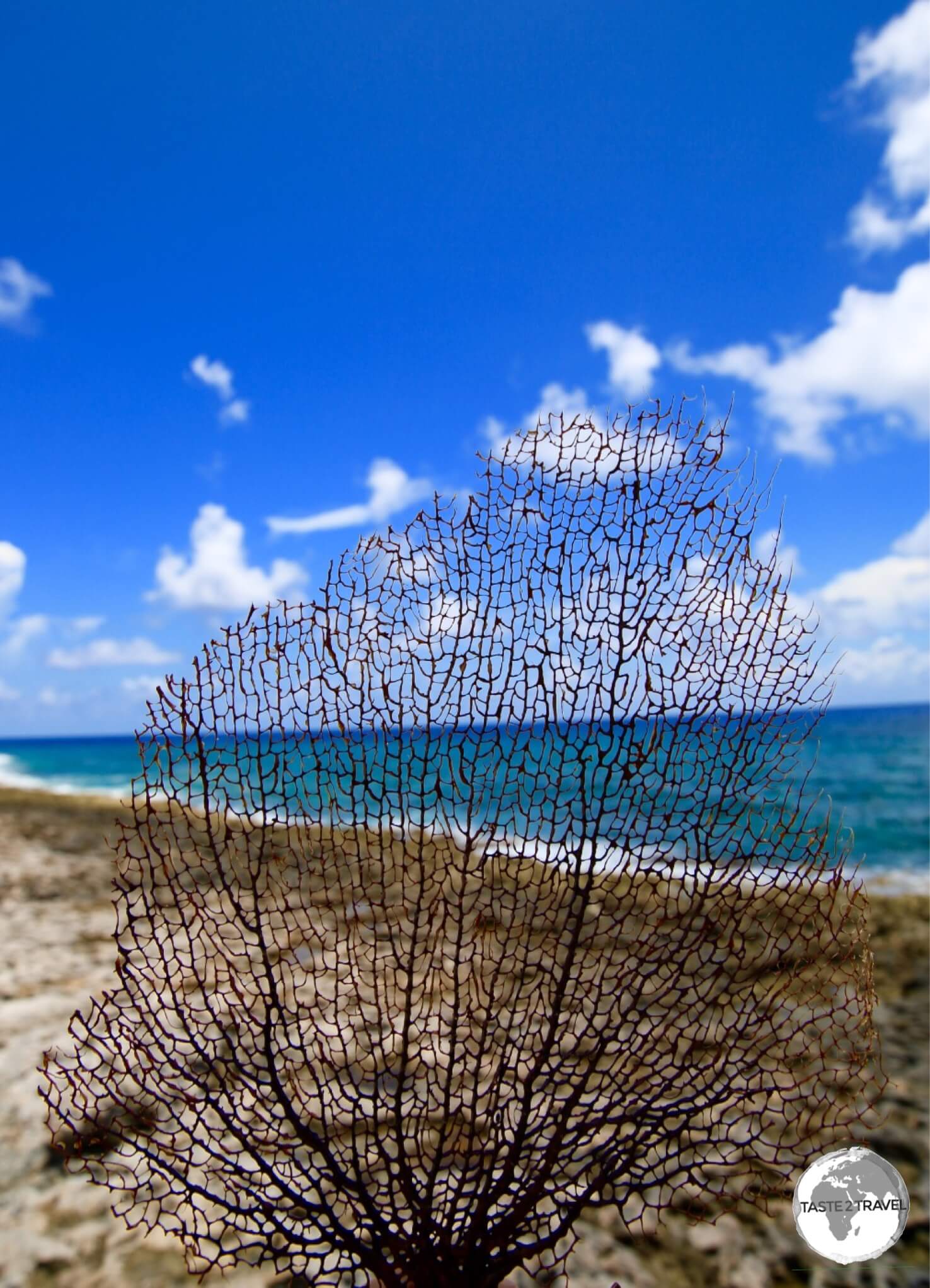
A fern coral at Long Beach, Cayman Brac.
If you wish to fully explore the trail you will need proper footwear. It’s best to visit the preserve early morning or late afternoon when the parrots are active. You can often hear them but they can be difficult to spot in the dense vegetation.
Housed in a former bank, the small Cayman Brac Museum is the oldest museum in the Cayman Islands and offers a fascinating insight into life on Cayman Brac. The museum is open Monday to Saturday (closed for lunch) and needs only a short visit.
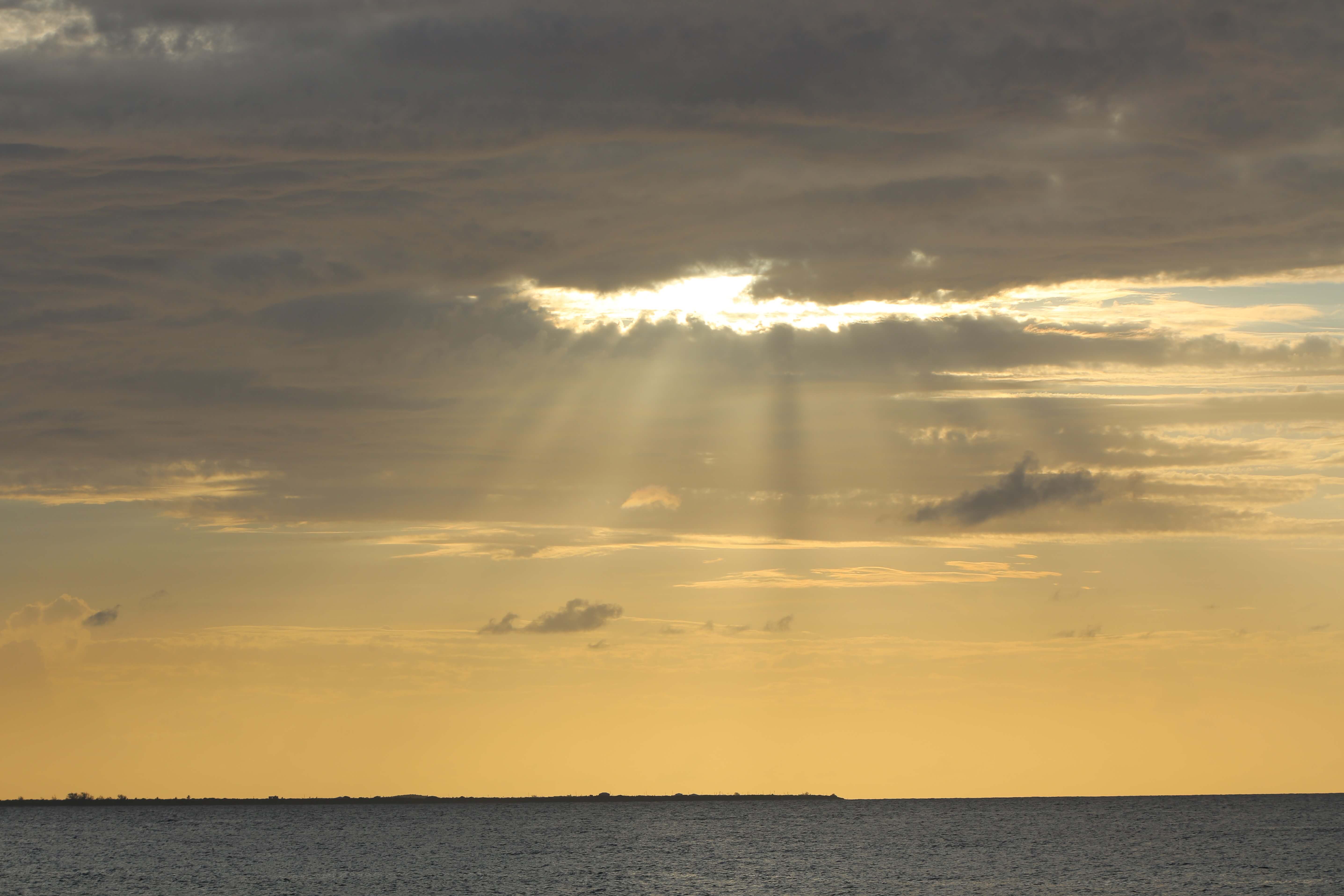
Sunset at West End Point, Cayman Brac – with Little Cayman in the distance.
The best sunset views on the island are from West End Point, which is accessible from the western end of South Side road. From here you can watch the sunset into the sea, while peering across the water to Little Cayman. I saw brown boobies here most afternoons.
Diving
While on Cayman Brac I dived with Reef Divers, who operate out of the Cayman Brac Beach Resort and offer full-service ‘valet‘ diving. What exactly is ‘valet‘ diving? Prior to entering the water, you sit yourself down on a seat at the back of the dive boat and relax while the crew fit you with all your equipment. Once done, you stand, step forward and plunge into the beautiful, crystal-clear water for which Cayman Brac is famous. Dive sites around the island feature lots of submarine canyons and tunnels and the great abyss – the Cayman Trough.
Accommodation
Grand Cayman
Most hotels on Grand Cayman are clustered along the pristine shoreline of Seven Mile Beach, where a room at a top-end resort will easily cost US$500 per night. Budget options are limited with budget hotels charging US$100+ per night.
I stayed at the more affordable Iron Shore Guest House, which is in the West Bay neighbourhood (you’ll need a car if staying here). The guest house is owned by friendly hosts Martin and Susan and includes a shared kitchen where you can prepare meals.
Cayman Brac
On tiny Cayman Brac, accommodation options are very limited. The largest resort, and the preferred choice for many divers, is the Cayman Brac Beach Resort which is located at the end of the road on the south-west side of the island. The resort features the best dive shop on the island – Reef Divers and the Tipsy Turtle Bar – the liveliest place on Cayman Brac. I did a day of diving with Reef Divers and would highly recommend them.
The few resorts on Cayman Brac are very expensive. I found a more affordable (but still expensive) private condo on tripadvisor.com which was located directly on the beach nearby the resort and came with a kayak parked out front on the beach.
Eating Out

Grand Cayman
With more than 200 restaurants catering to every type of budget – from a gourmet meal in the Caribbean’s only AAA Five Diamond restaurant – to casual “hole-in-the-wall” local eateries, there is something for everyone on Grand Cayman.
While there are restaurants scattered all over the island, the dining epi-centre is the tourist strip of Seven Mile Beach. Here you’ll find a string of restaurants, bars and cafes along the main road, while nearby, the new Camana Bay shopping mall also includes many fine restaurants and bars and a farmers market. A good place for coffee at Camana Bay is Cafe Del Sol – a local version of Starbucks, they have a 2nd branch in downtown George Town. My favourite pub/ restaurant along the tourist strip is The Lone Star Bar & Grill, which features live music most nights and the best burgers on the island.
Located in West Bay, Alfresco is a popular restaurant with locals, serving locally fish and seafood dishes in generous portions.
Another good breakfast option in West Bay is the Vivo cafe, which is a vegetarian cafe specialising in farm-to-table sustainable cuisine. The cafe is attached to a dive shop (Divetech) and – as part of the program to rid the Cayman islands of the invasive Lion fish – they offer (Lion) Fish ‘n’ Chips, the one non-vegetarian item on their menu.
A short drive up the road from Vivo is the Cracked Conch Restaurant and the less formal Macabuca, an ocean-front Tiki Bar, which is the best place to watch the sunset into the sea, while sipping a rum punch.
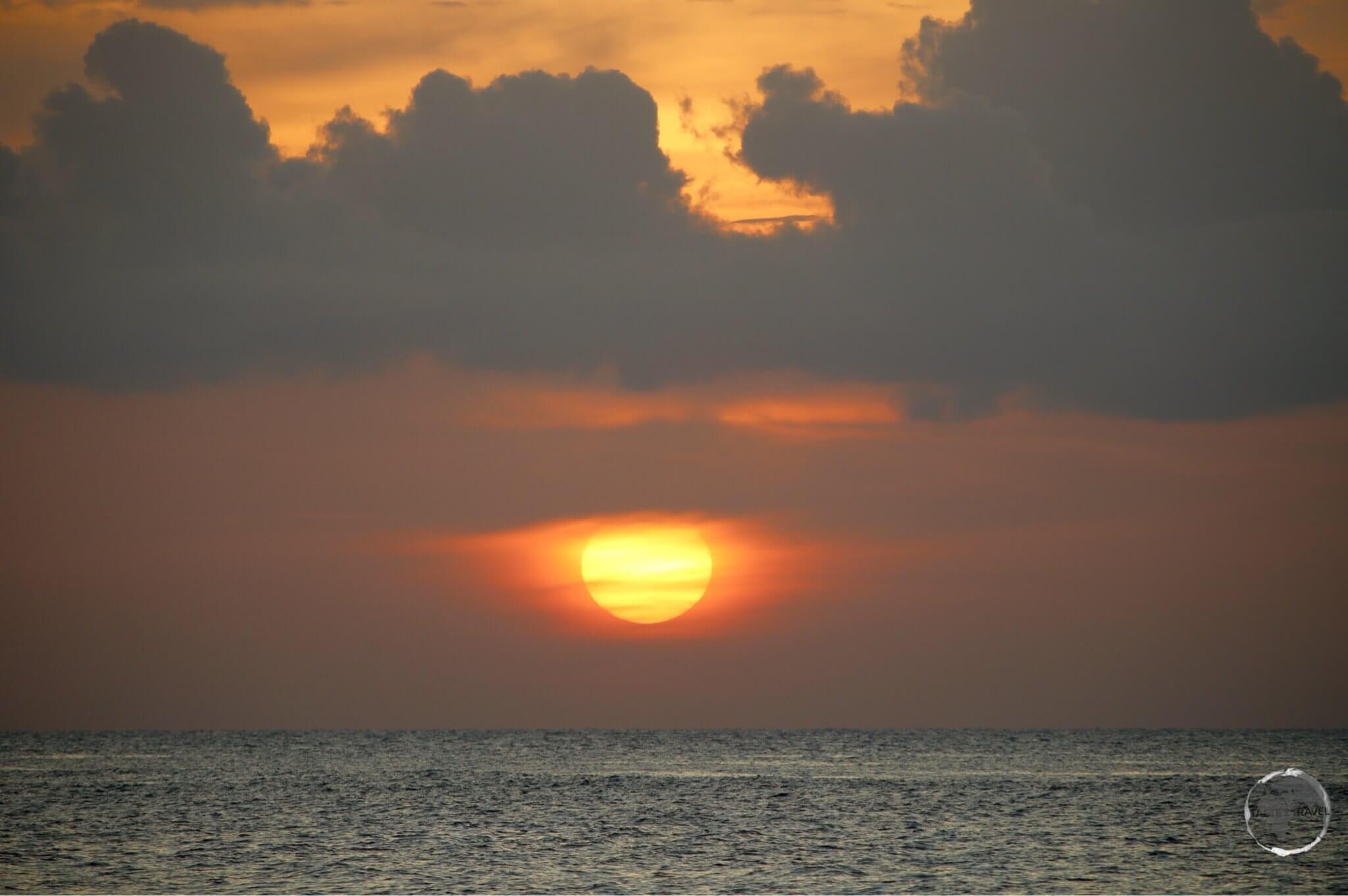
The sunset view from the Macabuca bar, Grand Cayman.
One of my favourite cafes in downtown George Town is Bread & Chocolate – a vegan cafe which serves up delicious, organic breakfast and lunch.
Venturing across the island, I found the best coffee at the Kaibo Beach Espresso which is an hour-long drive from Georgetown at Rum Point. The cafe is located at the Kaibo Yacht Club but shuts early in the afternoon. Next door is the Kaibo Beach Bar & Grill – a great place for lunch or dinner.
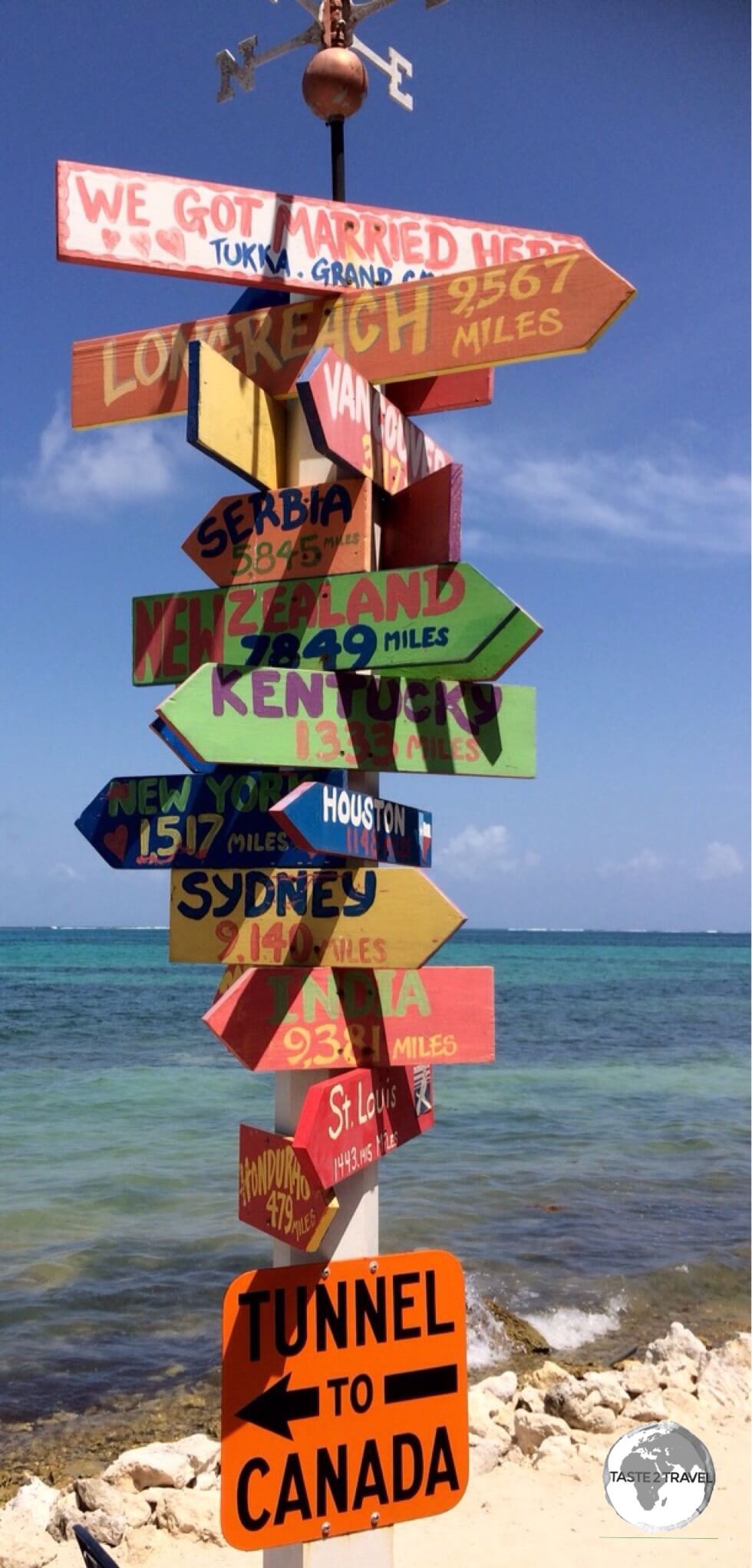
A distance marker at the Tukka restaurant, Grand Cayman.
In the far east of the island is the small coastal settlement of Gun Bay which is home to Tukka. Australians will recognise the name – it’s slang for ‘food’, being derived from ‘tucker’, and yes – the restaurant is owned by an Australian ex-pat – Ron Hargrave. I stopped here for lunch during my drive around the island and was glad I did. Tables are arranged on a breezy outdoor balcony which overlooks the sea – perfect!
The best fish fry I tried while on the island was at the hole-in-the-wall Captain Herman Fish Fry, which is located on the main road in the settlement of East End – highly recommended!
Cayman Brac
There are just a few restaurants on sleepy Cayman Brac and they tend to close early. The most happening place on the island is the Tipsy Turtle Pub, which is part of the Cayman Brac Beach Resort. The poolside bar is popular for lunch and dinner, offering American-style food such as burgers, fries, club sandwiches etc.
Located on the West End road, The Star Island Restaurant is an affordable, unpretentious diner catering to a local clientele. This was my ‘go-to’ place for breakfast each morning, where both the food and service were always good. The restaurant is run by Filipino staff of which there are some 200 (10% of the population) working on the island.
Just down the road from The Star Island Restaurant, Barracudas Bar is the another pub option on the island. Besides drinks, they serve wood-fired pizza, which is the best pizza on Cayman Brac.
Visa Requirements
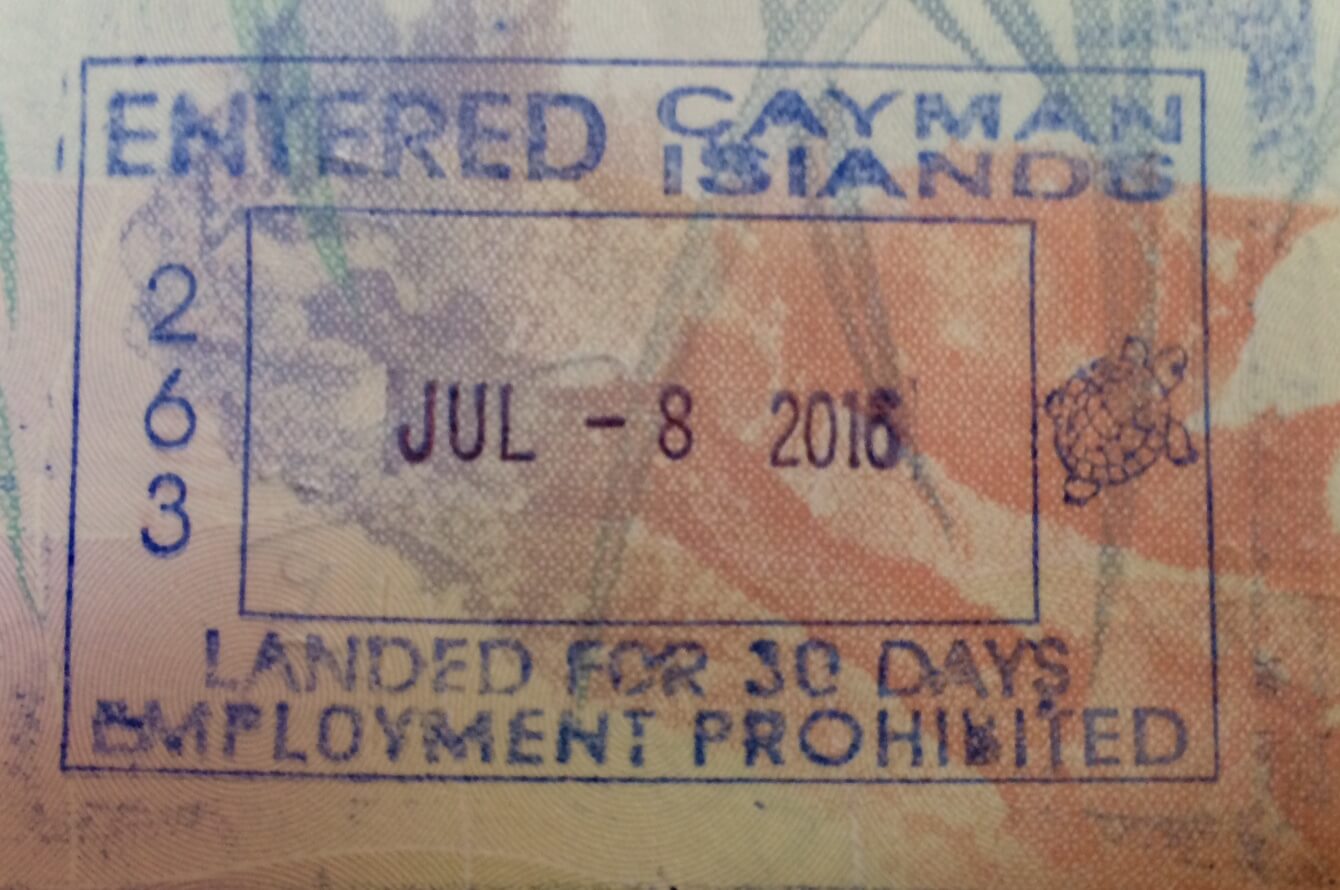
My Cayman Islands passport stamp.
Despite being a British Overseas Territory, the Cayman Islands have their own visa policy. Some nationalities require visas for the Cayman Islands – check your visa requirements prior to arrival.
Getting There
By Air

In 2016 – 23% of tourists to the Cayman Islands arrived by air, almost all of them landing at the main international airport – Owen Roberts International on Grand Cayman. The airport serves are the main base for Cayman Airways.
The small, old terminal is currently handling double the number of passengers for which it was originally designed. This results in constant overcrowding and translates into a bad user experience. At the time of my visit, access to the ‘air-side’ was via a single-file line which snaked through the departure hall. A new terminal is now under construction (due to be completed in 2018), which will more than double current capacity.
The following airlines provide connections to/from the airport:
- Air Canada – flight to Toronto–Pearson
- American Airlines – flight to Charlotte, Dallas/Fort Worth, Miami
- British Airways – flight to London–Heathrow, Nassau
- Cayman Airways – flight to Cayman Brac, Havana, Kingston–Norman Manley, La Ceiba, Miami, New York–JFK, Roatán, Tampa
- Cayman Airways Express – flight to Cayman Brac, Little Cayman
- Delta Air Lines – flight to Atlanta
- JetBlue Airways – flight to New York–JFK
- Southwest Airlines – flight to Fort Lauderdale
- United Airlines – flight to Houston–Intercontinental
- WestJet – flight to Toronto–Pearson
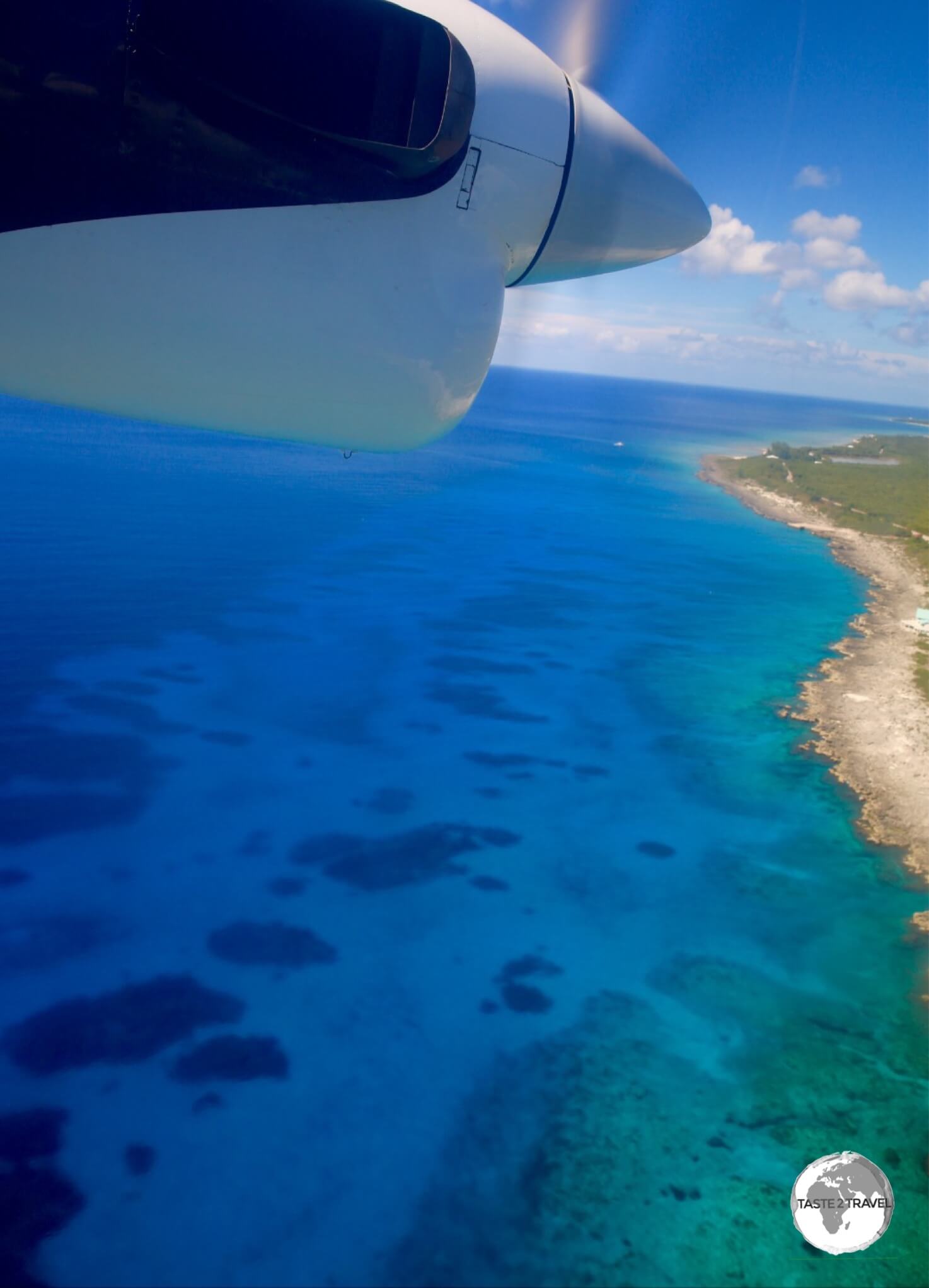
On approach to Cayman Brac with Cayman Airways.
The much quieter Charles Kirkconnell International Airport on Cayman Brac has (limited) international flights to Miami and Havana operated by Cayman Airways. The airline offers (frequent) domestic connections to Grand Cayman and neighbouring Little Cayman (a 5-minute puddle jump).
By Sea
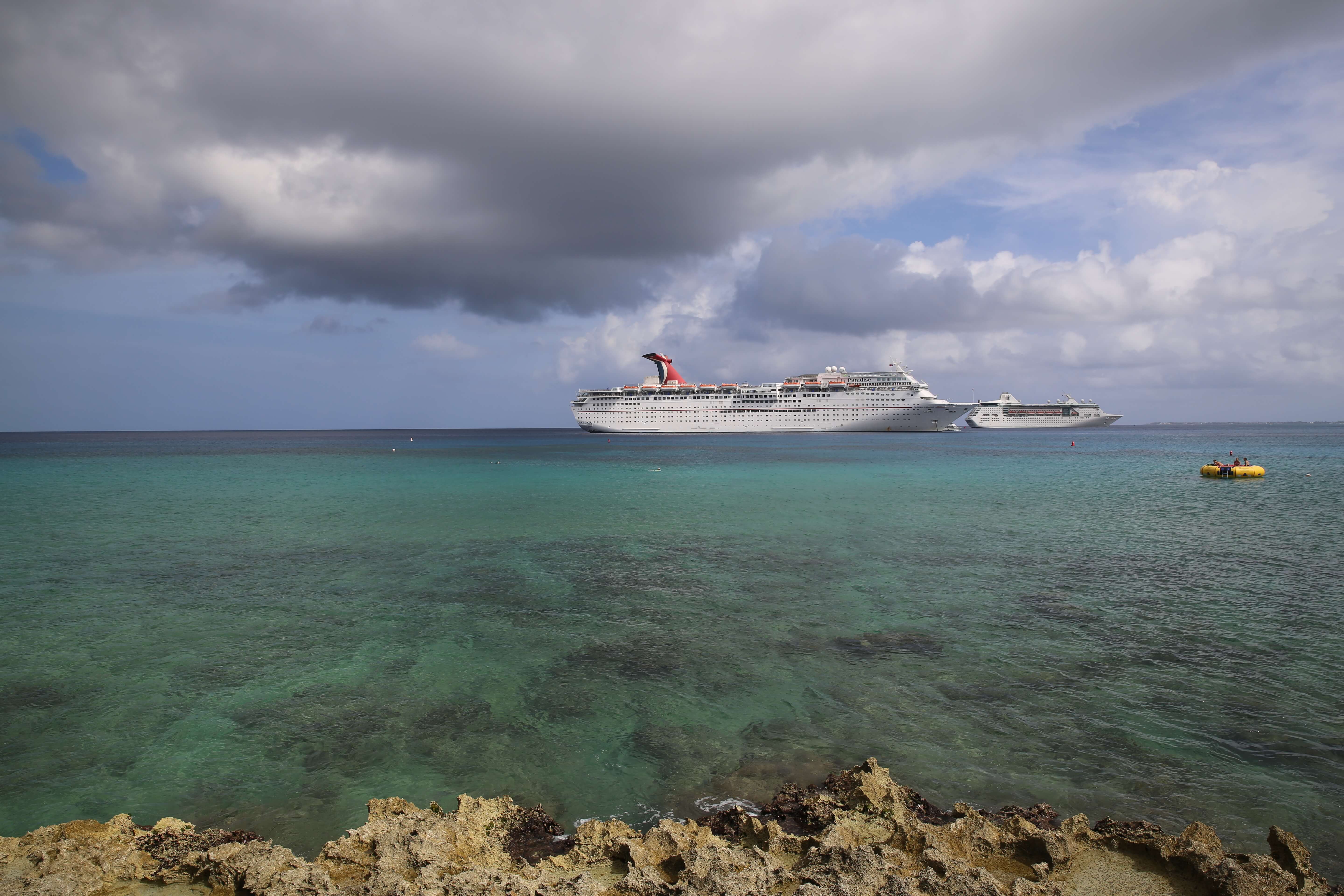
Cruise ships visiting George Town dock offshore.
In 2016 – 77% of tourists to the Cayman Islands arrived by cruise ship, all of which drop anchor off of George Town. All passengers come ashore using the Port of George Town’s tenders. Onshore, there are three docks, all located in downtown George Town – the Royal Watler Cruise Terminal, the North Terminal and the South Terminal.
The tendering of cruise ship passengers ashore wasn’t a big problem in the past, but with the advent of mega-liners carrying 5,000+ passengers, cruise ship companies have pushed the Cayman government to install a proper dock. This would require the dredging of the beautiful coral reef which wraps around George Town bay. The ecological damage would be significant. I did several amazing dives on the reef during my visit and was told many of the dives sites will be lost if the current plans (which the government has approved) go ahead.
Getting Around
Bus
Grand Cayman
The main bus terminal is on Edward Street, in George Town – adjacent to the Public Library. Fares can be paid in US$ or KY$. For a complete description of all routes (plus maps) click here.
Cayman Brac
There is no public transportation on Cayman Brac or Little Cayman.
Ferry
There is no inter-island ferry service connecting Grand Cayman to Cayman Brac or Little Cayman. If you are determined, you have the option of chartering a yacht or catamaran, which is not cheap.
On Grand Cayman there is a convenient ferry service which connects Camana Bay Shopping Centre with Rum Point. The drop-off is at the nearby Kaibo Yacht Club – home to Kaibo Beach Espresso – the best (freshly roasted) coffee I found anywhere on the Cayman Islands. The 35 minute boat ride saves you from a long, winding, hour-long road journey.
Taxi
Grand Cayman
There are plenty of taxis on Grand Cayman with a typical fare from downtown George Town to Seven Mile beach costing US$5. From the airport to George Town costs US$15. Fares increase quickly and if you plan on travelling across the island it is cheaper to rent a car.
Cayman Brac
There are several private taxis operating on the island, which you will need to reserve in advance through your hotel.
Car
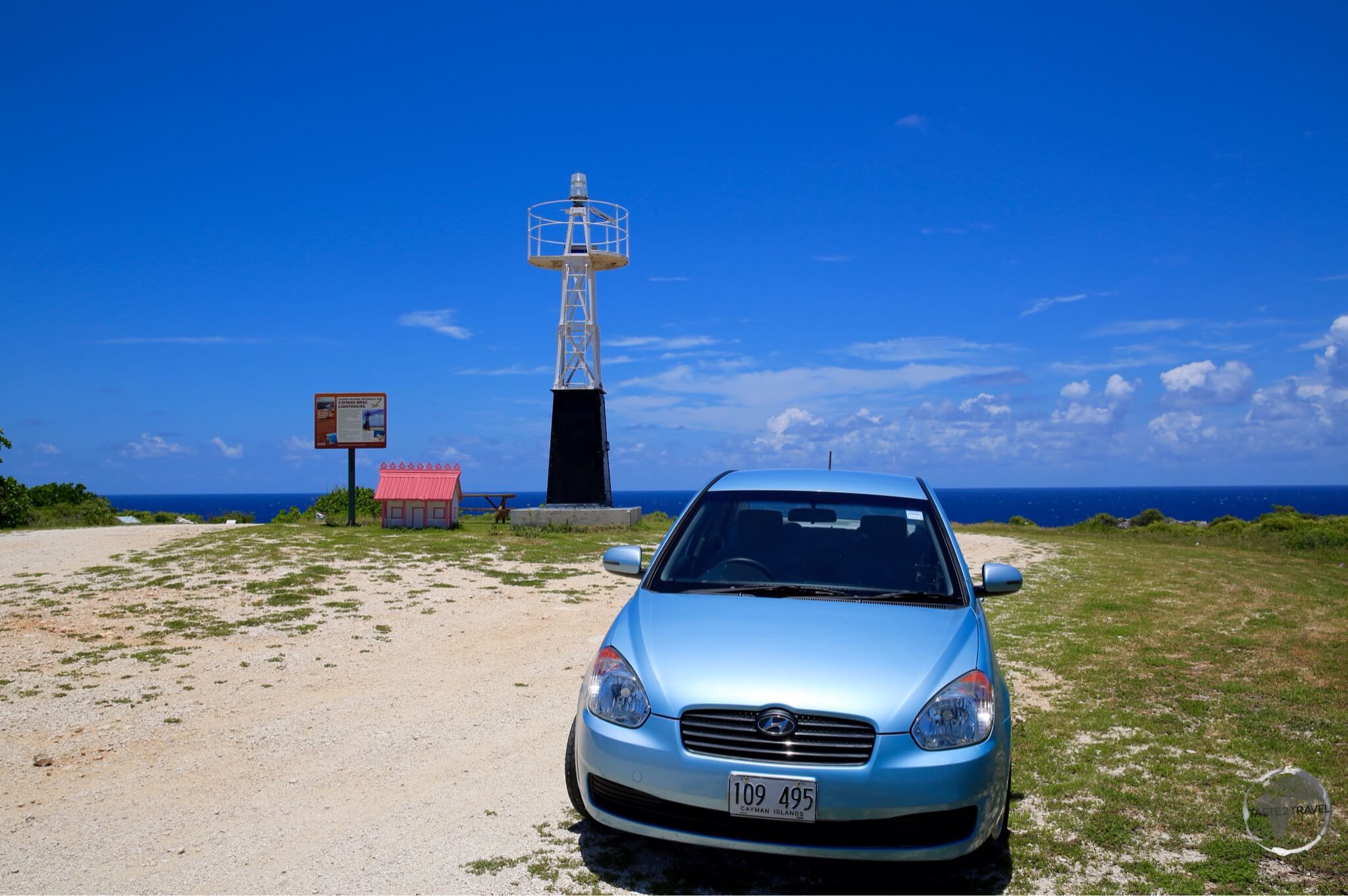
My rental car at Cayman Brac lighthouse.
Grand Cayman
The best way to explore the Cayman Islands (and maximise your time) is to rent a car. On Grand Cayman, there are a host of rental companies at Owen Roberts International Airport. I hired a car through Alamo at a reasonable daily rate. Like other English territories in the Caribbean, foreign drivers are required to obtain a visitor’s driving permit, which costs US$20 and are issued by the agent at the time of rental.
Cayman Brac
There is no public transportation on Cayman Brac so you either walk, cycle or rent a car, which you can do through CB Rent-a-Car who have their office across the street from the airport terminal. Driving on this island of just 2,200 souls is very laid-back and pleasant. It’s impossible to get lost with two long coastal roads (which cover most of the island) and a couple of connector roads.
That’s the end of my Cayman Islands Travel Guide.
Safe Travels!
Darren
Follow me on Instagram:
Further Reading
Other travel reports from the Caribbean region include:
- Anguilla
- Antigua & Barbuda
- Aruba
- Bahamas
- Barbados
- Bonaire
- Bermuda
- Cayman Islands
- Cuba
- Curaçao
- Dominica
- Dominican Republic
- Grenada
- Guadeloupe
- Haiti
- Jamaica
- Martinique
- Montserrat
- Puerto Rico
- Saba
- Saint Barthélemy (Saint Barts)
- Saint Eustatius (Statia)
- Saint Kitts & Nevis
- Saint Lucia
- Saint Martin/ Sint Maarten
- Saint Vincent & The Grenadines
- Trinidad & Tobago
- Turks & Caicos
- Virgin Islands (British)
- Virgin Islands (U.S.)
Cayman Islands Travel Guide Cayman Islands Travel Guide Cayman Islands Travel Guide Cayman Islands Travel Guide Cayman Islands Travel Guide Cayman Islands Travel Guide Cayman Islands Travel Guide Cayman Islands Travel Guide Cayman Islands Travel Guide Cayman Islands Travel Guide Cayman Islands Travel Guide Cayman Islands Travel Guide
Author: Darren McLean
Darren McLean is an Australian full-time digital nomad who has spent 36 years on a slow meander around the globe, visiting all seven continents and 239 UN+ countries and territories.
He founded taste2travel to pique one’s curiosity and inspire wanderlust.
